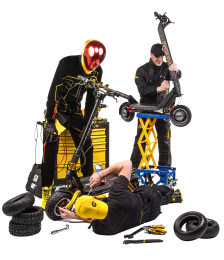Common Sense and Responsibility
Safety and Electric Scooters
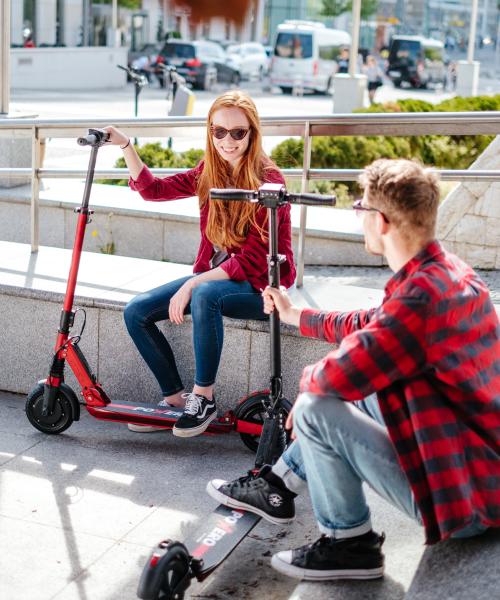
An electric scooter is an amazing mode of transport that means much more than just travelling from point A to point B.
It is about a joy on two wheels, a smile from ear to ear, lifestyle, sensible transportation in overcrowded cities and a reduction of our planet’s environmental stress.
We enjoy on a daily basis the possibilities, practicality and, in particular, the quietness and speed of our scooters. Let’s stop for a moment and talk about how to ride an electric scooter safely. Let us talk about what common sense and responsibility for our riding inside and outside a city tell us.

Safe electric scooter riding is influenced by three main aspects:
- Rider
- Scooter
- Environment and its conditions
There is no point wasting time blaming other people, pedestrians, cyclists or motorists. Complaining about the condition of our roads and sidewalks, our weather or drivers, does not improve our safety either. They may have a major impact on our safety, but we can not change them. However, what we can change is our behavior. We may not be able to influence all three aspects of our safety, but we can change at least two of them. And that is more than enough. Because problems arise when we, riders, fail to adapt to the conditions and situation around us.
For instance, if someone whizzes at 30 km/h on a poorly sprung scooter with small and solid wheels on a wet surface (as shown), such rider is asking for troubles even without any further contribution by nearby traffic participants.
What will you learn?
How to ride safely on electric scooter?
-
Active safety
-
Passive safety
- Contents
-
- Riding technique
- Steering rod and handlebars
- Acceleration
- Braking
- Turns
- Difficult terrain and conditions
Electric scooter is utterly different
Riding technique
“Well, it’s just a scooter… What riding technique are you talking about? Just step on it and ride!” – Actually, it’s not that simple. These days, the scooters can easily reach speeds not even cars or bikes are allowed to travel at inside a city, and for good reasons. An electric scooter is a completely different vehicle type that behaves utterly different than anything else travelling on our roads or sidewalks.
Electric scooters have nothing in common with bicycles! If you are an experienced bicycle rider, it does not say anything about your scooter riding skills. Scooters do not have large wheels that stabilize you by their gyroscopic effect. When you take your hands off the handlebars on a bicycle, such bicycle continues straight thanks to its large wheels and their gyroscopic effect. If you try doing it on a scooter, you will quickly find that it does not possess any such stability in the direction of travel. Even riding with a single hand on the handlebars is a dangerous experiment when it comes to riding a scooter. Your weight is distributed differently and the wheels are much closer to each other, which is why a scooter will never behave the same way as a bicycle. Moreover, you stand on a scooter, which means that the weight is distributed in a different manner and always rests entirely on your feet. Unlike riding a bicycle when your center of gravity and the bicycle’s center of gravity are relatively close to each other, a fact greatly improving stability. With a scooter, it is very much the opposite. Your center of gravity and the scooter’s center of gravity are far apart, which is why the scooter and your body behave differently in borderline situations.

Steering rod and handlebars
Riding an electric scooter requires working actively with the whole body and constantly shifting your center of gravity. An ordinary motor-less scooter is also controlled by body position, similarly to a motorcycle or a combustion-engine scooter. It is very important how you stand on your scooter and how you move the center of gravity forward or backward, especially while accelerating or braking. The entire rider’s weight must always rest only on his/her feet, similarly to standing on a skateboard or snowboard.
The handlebars and steering rod serve precisely for what their names suggest. For steering. Meaning, they have not been designed and, therefore, neither intended for carrying rider’s weight during rapid acceleration or braking. This is one of the most common mistakes even experienced riders make. Once you realize that you are forcefully gripping the handlebars, leaning against them or pulling on them, you are doing something wrong. Always remember that handlebars are for steering. That is why when accelerating on powerful models and when braking on all models you should work with the position of your center of gravity and compensate for your body’s inertia by leaning forward when accelerating and backward when braking.

Take a good look at your scooter. It is basically a deck on wheels and a long lever with handlebars at the end. Do you remember high school and the story of Archimedes who understood the transfer of power using leverage, uttering the famous sentence: “Give me a lever and a fixed place to stand and I will move the earth.”? What he meant was that if he had a large enough lever, he would be able to move the entire planet using just the strength of his muscles. The discovery of the leverage principle became a decisive turning point in the development of science and technology. Therefore, remember Archimedes and use your steering rood and handlebars for steering only. What happens if you push against the lever (steering rod) in forward direction? The scooter first lifts itself and rests on the front wheel only. Afterwards, the whole scooter body flips forward, which simply must end up by you falling down. Imagine riding an electric scooter as if you were riding a skateboard or snowboard where the weight of your body rests solely on your feet.
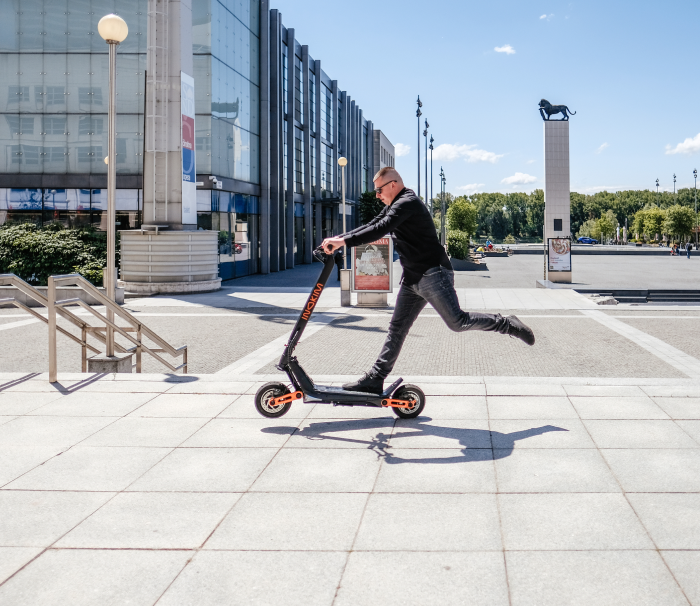
Acceleration
Many powerful models are capable of surprising even experienced riders by their acceleration. Combining high torque of electric motors with small wheels often leads to acceleration that subconsciously frightens riders who barely manage to stand on a scooter by hanging on the handlebars. However, this is the worst thing a rider can do as it shifts the center of gravity further backward with more weight suspended on a steering rod, reducing the downforce acting on the front wheel. This leads to poorer stability and loss of control over the scooter. Even where a rider does not fall and manages to remain on the scooter, the excessive stress acting on the steering rod and folding mechanism damages the scooter.
It is no shame to set a speed limiter at first and start gradually getting used to a scooter and its acceleration. Observe whether or not you are pulling on the steering rod while accelerating. If so, gradually find a position, in which you are able to accelerate fully without having to help yourself in that manner. By doing so, you will significantly improve your stability and ability to maintain full control over the scooter during acceleration. This will also ensure long serviceable life of your scooter. The scooter will repay you by many years of trouble-free riding with a folding mechanism and without any creaking and damaged joints or bearings.
You can’t beat the laws of physics. The rider’s body will always be delayed behind the scooter itself. This means that a rider will feel as if the scooter wants to “run away” from under him/her. That’s why it is always an instinct to hang on to the steering rod, to prevent the scooter from “running away”. However, as we have already said, this is the worst possible reaction. Imagine standing in a bus without holding onto any support when suddenly the bus driver accelerates abruptly. If we stand facing the direction of travel, we are unable to stay on our feet and fall down. However, if we stand sideways to the direction of travel and use our “rear” leg to support the body, we are perfectly able to cope with it without holding onto any support. And this is exactly how it works on a scooter where we even have a big advantage – it is we who decide when the acceleration starts, we are in control. Meaning, no acceleration can surprise us and we are able to prepare for it in advance.
Proper body position on the electric scooter during acceleration:
Hands loosely placed on the handlebars, not pulling on the steering rod in backward direction. Fingers not gripping the handlebars strongly, to retain sufficient feel for small corrections.
Body leaning forward as much as possible even before acceleration starts to prevent the center of gravity moving too far back. This position should be maintained throughout the acceleration phase.
Most of the weight rests on the “rear” leg, which supports the entire body. More powerful scooters are often equipped with a so-called footrest at the back of the deck, which can be used to rest a foot against it.
To achieve maximum stability, the legs are placed behind each other, as far apart as possible and turned in the direction of travel.
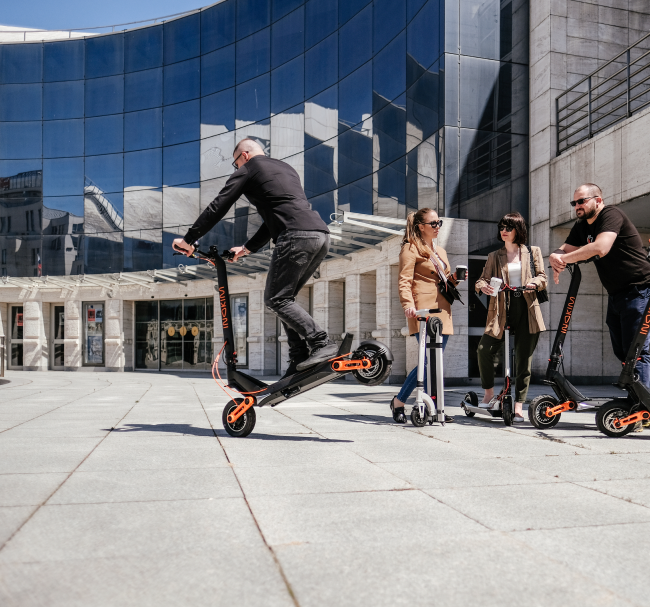
Braking
Braking, and especially heavy braking, represents one of the most dangerous situations in controlling an electric scooter. If you wish to brake most effectively and at the limit of what a given scooter can do, you will need to “feel” the scooter, have strong nerves and good knowledge of your scooter. It is much better to ride with anticipation and not get involved in any situations requiring maximum braking force. Naturally, a lot depends on how good your scooter’s brakes are. However, the basic principle stays the same.
Whenever braking heavily, the rule is that the rider’s body tries to “overtake” the scooter. When a rider is not prepared for that, it results in him/her instinctively leaning against the steering rod and transferring some of his/her weight to it. This damages the scooter since a steering rod has not been designed for leaning a body against it and, above all, it can lead to very dangerous situations. In such case, a steering rod acts as a huge lever reducing the downpressure acting on the rear wheel. Naturally, the rear wheel stops adhering to the road, locks itself and stops braking. Even if it remains lightly touching the road, it loses the grip because it is locked and the scooter loses directional stability. In extreme cases, this problem persists for a longer period and by his/her mistake the rider causes the entire scooter to tip over the front wheel, which sends him/her flying forward. A better scenario has the rider landing on his/her feet. A worse scenario sees him/her landing on his/her head or back. This is no theoretical talk. It is based on practical experience of dozens of our customers who because of their bad reaction fell down while breaking heavily. None of them was seriously hurt and we repaired their scooters. But it does not mean there is no need to learn how to brake properly and safely.
You can’t beat the laws of physics. The rider’s body will always be overtaking the scooter itself. Meaning, the rider will feel the scooter braking but his/her body will try to keep moving forward. That is why the instinctive reaction is to push against the steering rod so that the scooter does not stop without the rider. However, as we have already said, this is the worst possible reaction. Imagine standing in a bus without holding onto any support when suddenly the bus driver brakes abruptly. If we are standing facing the direction of travel, we are unable to stay on our feet and fall forward. However, if we stand sideways to the direction of travel and use our “front” leg to support the body, we are perfectly able to withstand it without holding onto any support. And this is exactly how it works on a scooter where we even have a big advantage – it is we who decide when the braking starts, we are in control. Meaning, braking does not surprise us and we can prepare for it better and in advance.
Proper body position on the electric scooter during braking:
Hands placed loosely on the handlebars, not pushing against them backwards or forwards. As a result, the scooter remains stable during braking, allowing better steering control and having no tendency to lift its rear wheel.
The rider holds his/her body as far back as possible, shifting the center of gravity and assisting in transferring weight to the rear wheel. It then brakes better and there is less weight resting on the “front” leg.
The entire rider’s weight is transferred to the “rear” leg while the “front” leg is used to prop against the scooter. The entire shoe sole surface should be used for that purpose. The feet must have good grip on the deck so that they do not slip but rather support the body weight.
The legs are always positioned behind each other on the scooter (never next to each other) as in this position the body has much better forward stability. We keep them distanced from each other as far as possible.
Locked wheel
However, the dangers of heavy braking do not end there. The vast majority of electric scooters is not equipped with the so-called ABS (only certain models), as we know this system used in cars or newer motorcycles. This results in wheels getting locked completely during braking, similar to a bicycle. This is dangerous even when riding a bike, which has better stability and bigger wheels that a scooter. A wheel lock during braking is far more dangerous on a scooter.
Scooter behavior with a locked wheel
It is much less dangerous to have a rear-wheel locked. Apart from a partial loss of rear directional stability, often you may not even notice it. You hear the tire whistling, and the scooter tends to swerve the rear wheel a little to the right or left. However, you significantly reduce the serviceable life of the rear tire and, naturally, because the wheel is skidding you do not have good control over its direction. However, it continues to be pulled behind the front wheel that is not locked, which means that the swerve does not tend to be extremely large.
It is much worse and more dangerous when it is the front wheel that gets locked. You will notice it immediately. The strongest manifestation comes with the immediate tendency of the scooter to slip either to the left or right. The wheel starts to pull in one direction and, at the same time, it tries to “lie down” on the road with the handlebars trying to escape your hands downwards in opposite direction. It is as if the scooter was trying to lie down immediately and without compromises, either to the left or right. This situation is very well known to bikers or drivers who drive cars without ABS (for instance, racers). The accompanying phenomenon usually comes with a loud tire whistling, however do not rely on it as when riding on a wet, unpaved or frozen surface it could all happen in silence.
In both cases, the locked wheel will refuse to turn and will continue straight. Therefore, if you happen to lock a wheel while in a turn, the instability will only get worse as the locked wheel will continue straight out of the turn. The rear wheel will “try to overtake you” and the slippage of the front wheel will result in immediate fall. Although it is possible to stop elegantly in a “drift” mode by deliberately locking the rear wheel while turning, which technique is often used by stunt riders, this riding style certainly should not be used on regular roads or sidewalks. The effect is caused by the fact that a locked wheel does no have the necessary traction and rather behaves “as on ice”.
Proper reaction to a locked wheel during braking
A locked wheel is always a tense situation because it is associated with maximum braking that by itself usually has a stressful reason behind it. The solution is very unnatural, which is why people usually do the exact opposite. You press the brake hard because your brain screams at you: “Stop, stop!” However, the only proper response is to gently release the brake. Releasing a brake lever by a millimeter or two is many times enough for the scooter to immediately return to normal, resulting in quickly restored stability. It is important to always release the brake that actually caused the lock. So, if it is the rear wheel that is locked, do not release the front brake and vice versa. In theory, all this sounds more than logical and as an obvious thing to do. However, in practice and when in stressful situation, we all make the same mistake.
You should remain careful even after the wheel is unlocked. It will start turning again, it will gain traction and naturally attempt to return to its previous state. This may mean that the scooter starts moving in a different direction than you expect, or that the handlebars get thrown in the opposite direction. That is normal. With some practice you just need to “catch” the scooter and continue braking. The entire process mentioned above should not last more than a second - two. Usually, it is done properly and “instinctively” thanks to the fact that the brain has already experienced it in the past and knows what to do. If the locked front wheel is not corrected almost immediately, the rider usually ends up falling down to the left or right.
When it comes to this, one must simply gain the experience and have strong nerves. There is virtually nobody who would be able to do it right first time it happens to him/her. People who have not experienced a locked wheel yet will probably not do it right first time it happens to them and will either fall or release the brake way too much, risking not braking enough to avoid hitting the obstacle.
Therefore, it is very important to try such braking out in advance in a safe and controlled environment, becoming better prepared for real emergency.
Preventing locked wheel
The motorbike instructors often compare this situation to squeezing a lemon or orange. It’s a good comparison and applies to all brakes that use a lever and are able to lock a wheel. Therefore, apply the braking force as if you were squeezing lemon juice. Decisively, but also gradually and not too fast. If you already feel strong resistance, it could mean that you have locked your wheel or you are very close to doing so. When a scooter starts to behave as if the wheel is actually locked, gently release the brake lever by a few millimeters. It is important to adapt the braking force and its gradual delivery to the environment, in which you are braking. The risk of a wheel getting locked is much higher on an unpaved, wet, cold or frozen surface. Or if there are any leaves, dust, sand or other impurities on it. In such conditions, it is necessary to maintain larger gap and brake less intensely and with less force.
Practice recommendation
If you wish to be a better rider and improve your safety, there is nothing better than to practice heavy braking in safe conditions. Try braking harder at lower speeds in a safe place and with good personal safety equipment. Gradually look for the moment you start losing control. Apply the aforementioned advice and you will see that it is not a rocket science. Over time, you will start doing it subconsciously. If you feel that you are leaning against the steering rod, you know that you are not in the correct position and that you are transferring too little weight backwards and “to the front leg”. An unpaved surface may cause the wheel to lock faster. For instance, on a gravel road you can lock a wheel even at 5-10 km/h. This allows you to practice your reactions at safe speeds. The saying “hard on the training ground, easy on the battlefield” also applies to practicing emergency braking. However, do not forget to wear appropriate personal safety equipment, such as a helmet, sturdy shoes and protectors.
Frequently used brake types and their specifics
Each brake type comes with its own specifics. Familiarize yourself with your scooter’s brakes as soon as possible and, from time to time, try out hard braking in safe conditions. You will discover how your scooter behaves when you need to stop it as soon as possible. Make sure to remember, which brake lever controls the front wheel and which one is used to brake the rear wheel. It is very important because while a locked rear wheel mostly does not cause any serious problem and you can stop quickly, a locked front wheel usually results in a fall. Be particularly careful if you use several types of scooters. Always remember what brakes are at your disposal with each model.
Electromagnetic (regenerative brake)
This is an amazing modern technology. It extends the range, it is maintenance-free and can brake surprisingly hard. However, its braking curve differs from a standard mechanical brake. The braking force is distributed differently and is often less effective at low speeds. According to our own measurements, you will always stop a little faster with a drum or disc brake. Therefore, make sure to maintain larger gaps with electromagnetic brake and ride sensibly. This brake’s advantage is that the wheel only locks on rare occasions and, therefore, a locked wheel hazard is significantly reduced. It requires no maintenance and always provides identical braking curve and force, even with repeated hard braking. Before going downhill on such a scooter, always make sure that the scooter is switched on. It is because the scooter won’t brake when switched off. This also applies to a scooter with completely discharged battery that no longer can be switched on.
Foot (step-on) brake
It is mostly used on ultralight models and exclusively on the rear wheel. The principle is the same as with brakes used in small, non-electric scooters where a foot presses the fender directly against the tire and brakes it in this way. It may sound primitive, but it works relatively well. With some practice, it is possible to lock the rear wheel and make it skidding. In such case, the scooter loses lateral stability and if you do it in a turn, the rear part of the scooter will start overtaking the front of the scooter. This braking method requires practice, being more difficult to control. The foot brake is suitable for assisting the front brake during emergency braking and for slowing down at low speeds. The braking efficiency can be enhanced by shifting the center of gravity as far back as possible. This braking method causes faster wear and tear of the rear wheel, which means it must be checked regularly.
Drum brake
This braking method is underestimated by many as drum brakes are no longer used in modern cars. However, there is a difference between braking a 1300 kg car and a 30 kg scooter. Drum brakes have many advantages over disc brakes in real-world application. Except for extremely powerful scooters, they can be a better choice, in fact. The drum brake’s main advantage is that it requires less maintenance and adjustment. Unlike bicycles, scooters have brakes positioned close to the ground and, therefore, these brakes get dirty more frequently, which may have an impact on the braking curve. However, a drum brake is closed, meaning it is excellently protected against any effects of the external environment. The whole brake adjustment consists of tightening the adjustment screw on the brake lever, which only needs to be done on an occasional basis. You will know that this screw needs to be tightened when you observe that the scooter does not brake immediately after pressing the brake lever and, therefore, there is some movement of the brake lever that does not cause braking. The entire adjustment process only takes about 10 seconds and requires no tools. Meaning, it is suitable for those who are interested in a scooter they just need to stand on and ride, without any frequent servicing necessary. Having a brake protected and closed eliminates the risk of damaging it during transport, when falling down, etc. We recommend having the drum brake lining replaced in an authorized repair shop. A drum brake is the best choice for scooters with top speed of about 40 km/h and for riders without any extreme sports ambitions. In normal use, it brakes comparably to its disc-based competitors. The disadvantage being poorer cooling, which is why it is not suitable for regular heavy braking from high speeds. Hotter the drum brake lining gets, poorer the braking effect. The braking efficiency of the lining decreases in case of repeated braking without sufficient cooling. When you see a drum brake used, it does not mean that a manufacturer is trying to save money. Even renowned brands are beginning to use drum brakes in city models, which is based on many years of experience.
Mechanical (cable-actuated) disc brake
The disc brakes are used almost everywhere around us – in cars, motorcycles, as well as bicycles. It is a very efficient braking method, which is able to stop repeatedly from high speeds thanks to good cooling. A brake disc is not covered by anything, which means it is well cooled by air. The mechanical version is a cheaper solution, yet still sufficient for most users. The disadvantage being the slightly worse response of the cable compared to hydraulic transmission of the braking force, which is more efficient and faster. The main advantage is the lower price and easier setup – there is no need to check any brake fluid or bleed it. It is equally easy to adjust as a drum brake. However, it needs to be adjusted more often. A common problem comes with a warped brake disc, cheaper versions of which are not designed for sports riding or harsh scooter handling. The warping manifests itself by uneven braking, “shaking” of the wheel and brake lever and by disc “whistling” while riding, even when not braking. The warping of the disc occurs most often by mechanical force, for instance when you place the scooter on its side with the scooter’s weight resting on the disc. It can also happen, for example, when transporting the scooter in a car trunk, or possibly when the disc hits a corner of a wall while pushing the scooter. Likewise, it can happen when a disc is cooled down rapidly from high temperature when a rider goes through a puddle with hot brake. A frequent reason behind a warped disc is a situation involving a rider braking very hard several times in succession, causing the disc to become too hot, and then stopping the scooter while keeping the brake lever pressed. The brake pads then exert pressure on the upper part of the disc which cools down unevenly and bends. That is why it is always good practice to cool down the discs by riding smoothly at about 20 km/h without any additional braking. This applies not only to scooters but also to cars and bicycles. In general, the cable-actuated disc brakes are equipped with weaker (cheaper) discs and brake pads in order to keep the price low. If your discs get warped often and you are sure that it is not you who is causing it by your riding style or your handling of the scooter, having a disc replaced with some other disc made by other manufacturer may help, or possibly you should use a slightly thicker disc.

Hydraulic disc brake
The same above principle applies to a hydraulic disc brake as well, so we only need to point out the differences. The main difference is that the braking force is transmitted from the brake lever not by a cable in a housing but hydraulically by a brake fluid. This fluid has a faster and more even reaction since liquids are incompressible. For this reason, higher quality components must be used, which naturally gets reflected in the price. The disadvantage being more difficult maintenance. Any possible brake fluid leak (tearing) should be monitored and, from time to time, the brake fluid should be replaced completely as prevention. Over time, the fluid may absorb moisture, which fact worsens its properties. A dangerous phenomenon with hydraulic brakes comes with air present in the brake system. It occurs when an air bubble enters the liquid, does not matter how small. Air is compressible and, therefore, the brake lever not only presses the brake pads to the disc, but it also compresses any air present in the brake system. It manifests as a “soft” brake lever that exhibits significantly worse braking effect. In such case, it is necessary to bleed the brake system in accordance with the manual. This is usually done by opening a dedicated valve that gradually releases air from the system while repeatedly pressing the brake lever. The air will always be found in the highest point of the system, which is why bleeding is a relatively simple process. However, if you are not sure, the safest option is to visit a service shop and have them show this process to you. In some models equipped with hydraulic brakes, the air enters the brake system when you place the scooter “upside down”, for instance during transport. That is why it is always better to transport these models with their wheels down. Be careful with a brand new scooter after unboxing it. You do not know how it was transported and the brake system may have air inside. Therefore, always check the new scooter thoroughly before riding it for the first time and test the brakes, particularly if they are of hydraulic type. This is the most effective braking method for repeated braking from high speeds, as it comes with best response and provides most precise control over the braking effect. However, not all riders are able to make full use of it.
Hybrid disc brake
Enough was already said above about disc brakes. However, for the sake of completeness, we must mention that there are also hybrid brakes. They are used, for instance, in the SXT Ultimate LITE model. This is a system where braking force is first transmitted from brake levers by a cable terminating in the brake valve. This valve is filled with brake fluid, thanks to which the force is transmitted to brake pads hydraulically. It may sound weird, but it is definitely not a bad idea. It eliminates some of the problems associated with the presence of air in the brake system many models suffer from, because here the hydraulic system is much shorter and sealed better. This system combines the advantages of both systems while minimizing certain disadvantages. However, the most effective braking method for repeated braking from high speeds remains the pure hydraulic system as it has the best response and provides most precise control over the braking effect.
Combined brakes
The combined brakes are those that combine multiple brakes on one wheel. However, they do not use the hybrid cable/hydraulic method as described above. Usually, this involves combined electromagnetic (regenerative) and mechanical braking. The main advantage is the reduced tear and wear of the mechanical brake as some deceleration is provided by the motor and the mechanical brakes just finish the braking job. The disadvantage comes with poorer control over the braking curve, as riders do not have separate control over each brake. They only control the mechanical part and it is the control unit that decides on the use of regenerative/electromagnetic brake. The braking force can be partially adjusted in these models using the scooter display menu. This is a good solution for scooters designed for long-distance transport without any sports ambitions. As a result, the scooter spends less time in a service shop and lasts longer distances without maintenance.
V-Brakes
They are used, for instance, in the Quick 3 model by Inokim, although they are more known to be used in mid-class bicycles. This system uses cable to transmit power from a brake lever and is adjusted similarly to a mechanical disc brake. However, it does not press brake pads against the disc but rather presses them directly against the wheel. This gives you visual control of how much brake material remains available. The main disadvantage of these brakes is the appearance, since they are relatively large – there is not enough room for them on small wheels. That is why they are more suitable for larger wheels. Because of their appearance, they are rarely used on scooters and have been replaced by drum or disc brakes.

Just one brake
There are many light and cheap scooters that only have one brake on the rear or front wheel. For instance, the ZERO 8 model only has a brake on the rear wheel with no brake at all on the front wheel. This solution helps reducing scooter’s price and weight, however it is the least safe option. There is no redundancy when braking and the braking distance is usually longer compared to models with brakes on both wheels. If you have a scooter with just one brake, it is important to anticipate and, also, to maintain sufficient gap in case of any unforeseen situation. With such models, we always recommend riding slower and more carefully. The speeds above 20 km/h should only be used with excellent visibility around you, for instance on a long bicycle route where there is no danger of anybody suddenly crossing your path.
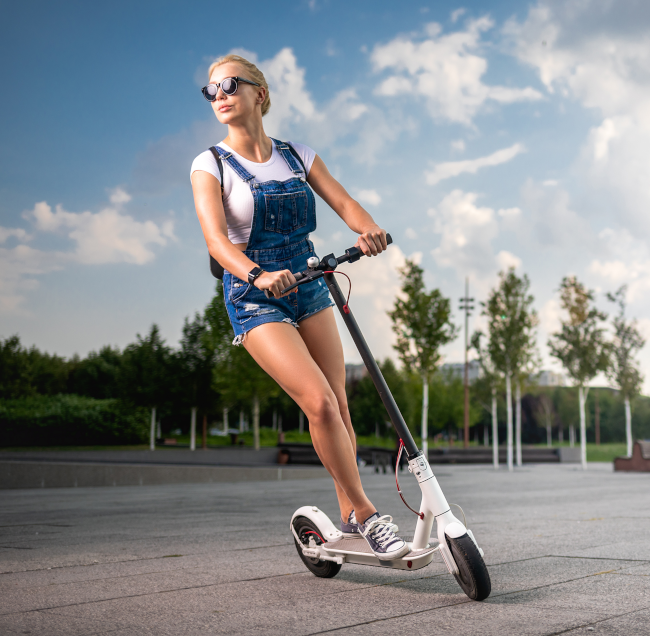
Turns
Changing direction and going around a curve on an electric scooter both depend on the speed. There is hardly any problem making a turn when riding slowly at a pedestrian pace. You just turn the handlebars in the direction of a turn and the scooter obediently changes direction as needed. However, the situation changes rapidly when your speed increases and the gyroscopic effect of spinning wheels, the centrifugal force and the scooter’s inertia all enter the equation.
There are two ways to make a turn on a scooter while riding. By turning the front wheel using the handlebars and, at higher speeds, by leaning similarly to what riders do on motorbikes. The faster you travel around the bend, the more you need to lean. You can’t fool the laws of physics. The centrifugal force, as well as inertia, will indeed act on your body. If you fail to lean on the scooter and attempt to turn left (for instance), the centrifugal force will start pulling you to the right (out of the bend) and it will be very difficult to remain standing on the scooter. By leaning towards the bend, you are able to neutralize the centrifugal force and make the turn safely.
Position when making a turn
The rider and the scooter should lean at the same angle. The experienced riders may lean even more than the scooter itself, allowing it to lean at a smaller angle. This is used with sports riding. However, the recommended lean angle for beginners is identical to the scooter’s lean angle. Conversely, if the scooter’s lean angle is greater than that of the rider, this situation is dangerous as it increases the risk of wheels slipping.
The hands rest freely on the handlebars and the rider does not lean against nor pulls on the handlebars.
The rider’s legs are behind each other, not next to each other. This position improves stability when braking is required. It is not necessary to have your feet next to each other as the centrifugal force is balanced by leaning.
The wheel points forward and its angle stays the same while taking a turn.
Braking and accelerating
Braking and accelerating while cornering is dangerous because in such case more forces acting in directions other than the direction of travel join the centrifugal force. Even a gentle tap on the brake lever while taking a turn causes the scooter to attempt to change its lean angle and continue travelling straight – out of the bend. That is why it is best, especially for beginner riders, to avoid braking or accelerating while taking a turn. If you need to start braking in a bend, be prepared that the scooter will apply more pressure to continue straight out of the bend. It will be necessary to force it to continue along the selected curve – i.e. you will have to smoothly increase the lean angle towards the bend. When you stop braking, it will be necessary to smoothly reduce the lean angle. If you manage to lock your front wheel while cornering, it will probably result in an immediate fall caused by an understeering skid. Therefore, it is necessary to handle your brakes very carefully and, ideally, not to brake at all while cornering. The locking of the rear wheel in a curve results in the rear wheel immediately attempting to leave the curve and continue straight out of it (oversteering skid), which manifests by a feeling that the rear wheel is trying to overtake the front one. All you need to do is to release the rear brake to make the scooter return to normal and continuing cornering. Therefore, the general rule is that while taking a turn it is safer to brake using the rear brake than the front one, although the safest option is to take a turn at such a speed, at which you are sure that it will not be necessary to brake while cornering. If you manage to resolve the situation involving skidding while making a turn by releasing the brake that caused the skidding, you still have to deal with the fact that at the very moment your wheel regains traction, it will attempt to throw you in the opposite direction – the so-called kick – which may cause secondary skidding in the opposite direction. Nevertheless, this kick is weaker and lasts for a shorter period, so it is easier to handle.
Bend surface
The condition of road surface is much more important when it comes to safe cornering than when going straight. It is because the tires must counteract the centrifugal force in the form of friction against road surface. As soon as this friction becomes insufficient for compensating forces acting in the direction out of the curve, the wheels start skidding and a fall ensues. That is why on a wet road you can ride in the direction of travel as fast as on a dry road and nothing happens to you. However, if you start taking a turn, which you can pass without problems just by leaning when the road is dry, in case of a wet surface the tires may not have enough grip and the scooter falls sideways with the handlebars pointing towards the turn. Naturally, you follow the scooter to the ground. It is very difficult to estimate the exact limit of what tires are able to handle as this limit varies with each scooter and rider. With poor road conditions (humidity, cold asphalt, dust/gravel on the road, etc.), it is best to corner at a slower speed. If there are any bumps, potholes etc. inside a curve, the only reasonable response is, again, a slower speed. Any potholes or bumps may cause the front wheel to get thrown away and start oscillating, or possibly losing the grip completely. These recommendations also apply to riding straight as you never know when you will have to avoid some unexpected obstacle.
Counter-steering
It may sound illogical at first, but the quickest way to make a sharper turn on a moving scooter is to first turn the handlebars slightly in the opposite direction of your intended path and then return them to straight position. This technique is well known to bikers. After practicing a little, everyone quickly becomes fond of it. This is because turning the handlebars briefly leans the scooter smoothly in the opposite direction to the direction the handlebars are pointing to. As a result, the scooter starts to turn in the direction opposite to the initial impulse. All you have to do then is to point the handlebars straight and the scooter starts turning nicely in the desired direction. This is better as the scooter starts leaning by itself and all you need is to make your body copy its lean angle. This is an advanced riding technique and we definitely recommend testing it only if you have sufficient space around you and wear personal safety equipment. This effect will not manifest at low speeds, in which case the scooter will rather start turning in the direction the handlebars are pointing to. However, the faster you go, the stronger the effect is. Therefore, it takes practice and getting used to in order to be able to estimate well how strong of an impulse the scooter needs and at what speed.
Rider turns the handlebars slightly to the left.
Scooter leans to the right.
Rider returns the steering rod to neutral position, i.e. the wheel points straight again.
The centrifugal force counters the gravitational force.
-
Physics behind leaning
Why is it that the leaning of a scooter does not cause it to fall down but rather starting turning?
If the scooter were standing still – it would simply fall down when leaning, as the only significant force acting on it would be the gravity and the scooter’s center of gravity would be outside of its base. However, since the scooter moves at a considerable speed while riding, this speed acts in a manner making the scooter standing upwards (thanks to the gyroscopic effect of rotating wheels) and turn when leaning (thanks to the gyroscopic precession effect), and this leaning equalizes the centrifugal force. If you take a spinning wheel and start turning it, due to gyroscopic precession the spinning wheel starts leaning towards the imaginary bend. And vice versa, if you imagine leaning a spinning wheel towards the imaginary bend, thanks to the same effect it will starts turning inwards.
So, why is it that all two-wheel vehicles must lean while passing a bend?
It is about maintaining balance against the centrifugal force. This force always acts in the direction out the bend and the scooter with the rider compensate this force by leaning in the opposite direction. The balance between the gravitational force and the centrifugal force then ensures stability and the rider does not fall despite leaning (if the rider were leaning like this but not moving, the rider would fall to the ground). More information about these physical phenomena can be found on Wikipedia page. The details of gyroscopic precession are described in more detail on this page. From the rider’s point of view, it is essential to accept that if you want take a corner at a higher speed, the rider will have to lean correspondingly, and if the rider leans less than necessary, the scooter will have to lean even more, which is not a safe method of going around a curve.
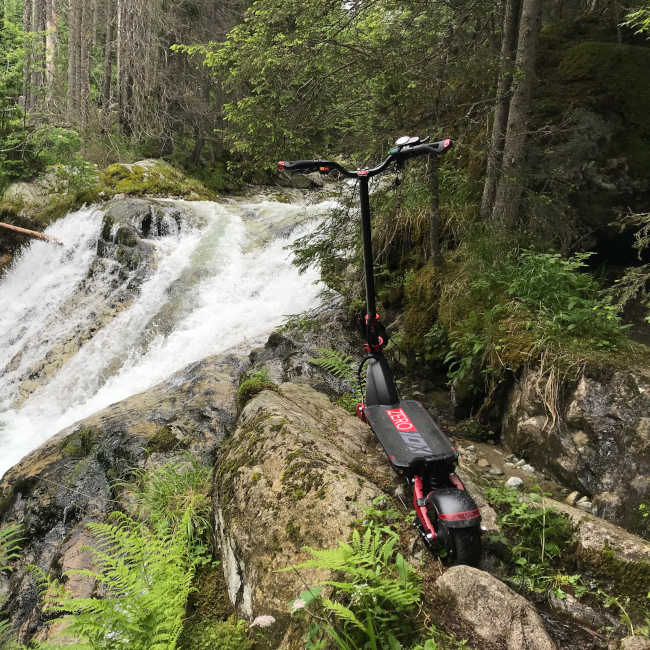
Off-road and difficult road conditions
Riding off-road and in more difficult road conditions can be challenging even for experienced riders. That is why I wrote down a few tips that may help improving your safety and, ultimately, your riding pleasure.
Wet or dry surface
Most scooters do not officially provide any water resistance, not even against running water. The operating manuals clearly state not to ride in such conditions. Not only for your own safety, but also because of the fact that water damage is not covered by warranty and new electronic components or batteries are quite expensive. Therefore, do not ride on a wet surface. In Slovakia, the ALADIN model provided by the Slovak Hydrometeorological Institute (SHMÚ) is a very good source of short-term weather forecasts. In the Czech Republic, you can try the ALADIN model provided by the Czech HMI. The koponyeg.hu server is available in Hungary. In general, the Yr.no server (a website of the Norwegian Meteorological Institute) provides quite accurate forecasts for CZ, SK, HU and UA. If it is already wet in the morning, or if the forecast suggests raining during a given day, it is safest for you and your scooter to choose some other mode of transport.
Warning!If you decide to ignore the above information, you risk violating your warranty conditions and you endanger your own safety. If, despite all of the above, you simply have to ride, I recommend slowing down significantly.
The scooter will brake poorly and, particularly, it will make turns much worse than usual. A curve you are used to go around at 30 km/h will require slowing down in the rain to a maximum of 10 km/h as any mixture of water with dust or fallen leaves is very slippery. Not speaking about engine oil, which floats on the asphalt surface due to water. In addition to riding slowly, do not forget to turn on the lights, both front and rear, as other traffic participants experience poor visibility and may not notice you, not even during day hours. If you decide to continue riding, stop for a moment and make sure that the scooter’s charging connector is closed properly, the same applying to the USB connector on the display, if you have any. The water often penetrates into the electronic components because scooter riders fail to close these connectors properly after charging.
Some scooters can survive running water. However, almost none of them can survive immersion or a powerful water stream. You should be therefore aware that your scooter (with some exceptions) is not suitable for riding in the rain or on a wet road. You risk permanent damage to electronic components that may not show up immediately after a long trip in the rain. As it often happens, water enters into the electronic components in a tiny amount, which increases humidity and initiates the oxidation process. It may take weeks for it to manifest as a scooter malfunction. The most dangerous is riding through puddles as when travelling at speed one often can’t see how deep these puddles are and, also, what lies on their bottom. There could be a deep hole hiding there or stuck leaves that cause skidding. When you go through a puddle, we are no longer talking running water but rather water ejected under pressure that can easily penetrate into the scooter through seals and, at the same time, this involves immersion, for which even scooters with enhanced water resistance are not certified. Therefore, the rule is that riding through a puddle is a very bad idea with all electric scooters. Riding in the rain or just after it stopped raining is a very bad idea from the viewpoint of riding safety and, on most scooters, also from the viewpoint of long-term reliability and warranty conditions. Therefore, it is generally a good recommendation to avoid riding on a wet road and, where not possible, to ride much slower and always avoiding any puddles. We should neither forget the fact that most scooters do not have any functional fenders, meaning you will later find on your back any dirt present on the road.
If you notice anything unusual happening to your scooter after riding it in the rain or on a wet surface, or if you hear any unusual buzzing sound or other strange noises, turn it off immediately and take it to a service shop. If water entered the electronic circuits, it may result in a dangerous short circuit, fire, or damage to the electromagnetic braking system. Caution is also appropriate with scooters that are certified for running water, as seals can be damaged by long-term vibrations, effects of air, road salt etc. Moreover, it is no longer possible to speak of running water when passing through a puddle at a high speed since water ejected by the wheel is under significantly higher pressure than normal rain.
To see the real consequences of moisture penetrating into the scooter, check the section on charging and batteries, in particular the section on effects of moisture.

Riding on unpaved surface
If you have a scooter that has been designed for it, you can safely enjoy riding on unpaved surfaces, such as field roads, grass, forest roads and the like. Particularly suitable for these surfaces are scooters fitted with suspension, appropriate tires (there are road, semi-off-road and off-road tires), sufficient power and wheel sizes of 10 inches or more. Off-road riding is very funny and eye-opening as it makes it easier to discover the limits of both the rider and the scooter. If you have a suitable scooter, this is a fantastic way of spending time with friends.
The basic principle of riding on unpaved surfaces is to let the scooter choose its own route. If you grip the handlebars forcefully and transfer your weight to them, it will make your stability worse and you will fall down more easily. Do not push on handlebars, just hold them lightly and let them “dance” in your hands. If you observe yourself hanging on, or leaning against, the steering rod while forcefully gripping the handlebars, try to slow down and relax a little. You will see that if you give your scooter more freedom, it will choose a more stable path on its own. Quality personal safety equipment, such as a helmet, sturdy shoes and protectors, should be a matter of course. When riding off-road, it is better not to ride alone but have a friend with you. If you fall or somehow damage your scooter, your friend will help you. You will not have to walk back from the forest alone while pushing a heavy scooter, sometimes over a 20 km distance. Not to mention the necessary first aid after falling down.
If the surface is very loose, transfer more weight towards the back and lighten the front wheel a little. This will facilitate smoother ride through a difficult spot, especially if you have a scooter with two motors or a rear-wheel drive. It may seem a bit unintuitive, but by shifting the center of gravity further back, the front wheel stops sinking deeply into the ground and gains better traction and stability.
When riding down a steep hill, it is a good idea to move as much weight as possible towards the back of the scooter, similarly to when braking heavily. Where a rear brake is sufficient for braking down the hill, using it is much safer than when using the front brake simultaneously. Any skidding will not result in a fall. If the scooter starts gaining speed dangerously while only using rear brake for braking, start braking with the front brake as well. If the wheel starts to skid and the scooter continues to accelerate, it is best not to wait until the speed increases any further and simply jump off the scooter. Better now than when you are travelling by 20 km/h faster.
When riding up a steep hill, it is necessary to move as much weight as possible towards the front of the scooter, similarly to when accelerating heavily. Be prepared that the wheel may stop moving and start slipping on the spot, the scooter being unable to climb to the top of the hill. In such case, it is best to release the throttle lever, jump off the scooter, hold the scooter by handlebars, turn it slowly and then ride it back down the hill. Before jumping off the scooter, it is especially important to release the throttle lever if your scooter has a rear wheel driven (or all wheels driven) in order to prevent the scooter doing a “wheelie” and escaping your hands, or you getting pulled behind the scooter.
However, there is never a need to push your scooter too hard. Always keep in mind that a scooter is not an off-road motorcycle (a motocross bike) and has not been designed for rough off-road handling. For instance, if you damage any swingarm, bearing or suspension by jumping with your scooter, it will not be accepted under warranty and you will have to pay for the repair. The manufacturer knows exactly how much the individual components are able to withstand and, depending on the type of damage, they will know immediately whether a shock absorber hit the end position too hard or what force acted on the swingarm.

Riding in the dark and fog
I am yet to see a scooter with standard lights sufficient for swift and long riding in poor lighting conditions. Most “factory-installed” lights on scooters have been designed rather to make you visible to others than to allow you to see well at higher speeds in the dark. Therefore, I highly recommend not to rely on standard lights only. If you are planning to take long trips in the dark, invest in high-quality extra lights featuring independent power supply. And if you are really serious about it, go and invest in two such lighting systems. The independence of additional lights comes as a major safety enhancement when riding during the night. There is usually enough space on handlebars. And even if not, do not forget that the steering rod itself can perfectly serve as a place for attaching accessories. A helmet with a built-in light or possibly turn signals represents an excellent extra piece of equipment, as well as standard rear flashing lights used by cyclists that can be attached to your clothes or a backpack.

Riding with a load
Whether it is your purchased grocery, a notebook or a bag of sand you bought in a store selling building materials, any poorly distributed weight will definitely affect your ride. The worst solution is to hang any baskets or bags on the handlebars. Sure, they can handle a small purchase weighing a few kilograms, but your stability will be severely affected because of its inertia. For instance, if you turn left, the contents of the basket, or a whole bag, will start pulling to the right because of inertia. This may lead to front wheel oscillation. This is neither pleasant nor safe as you have no control over the center of gravity that keeps constantly changing from side to side. Therefore, any load belongs to a backpack you carry on your back. It is more stable there, it does not move from side to side while you take a turn and you control it together with the position of your body. Also, be careful not to exceed the maximum permissible weight of your scooter when carrying the load as in such case the bearings, shock absorbers and other components suffer extremely. In the case of large potholes or bumps on the road, some parts of the scooter may crack or even break.

Low temperatures
Low temperatures do not constitute a reason not to ride an electric scooter, provided that it is dry outside. Many people ride their scooters year-round and that is how it should be. You need to dress correspondingly, definitely wear some thick gloves as numb fingers do not have the same strength and precision to operate the brakes. A helmet takes precedence over a cap. So, if you can’t wear it under your helmet, you should rather buy an insulated helmet than ride without any helmet. Keep in mind that although low temperatures do not damage Li-Ion batteries, they slow down certain processes inside them and it is not possible to utilize their full capacity. Therefore, if you leave your scooter outside in the cold, it will not provide you with its usual range. In harsh winter, this range may be by 30-40% shorter than in summer. This lower capacity should be taken into account so that you do not end up somewhere halfway into your trip with a fully discharged battery.
Also, keep in mind that you do not have winter tires like cars do. So, it is likely that the tire material will be much stiffer than in the summer. This leads to longer braking distances and poorer grip when making turns. Therefore, you should ride a little slower. I also recommend reading the section on riding on a wet surface and in the rain. This also applies to winter – when it is wet and cold, it is best not to ride, and this for several reasons. Naturally, the scooter will not brake at all when travelling on ice and, if you try to take a turn on ice, it will usually result in a fall. If you accidentally find yourself riding on an icy surface in the winter (for example, on a frozen puddle), the only thing you can do to avoid falling down is to continue in the direction, in which you entered the icy surface. Braking will not help you either and you should certainly not attempt to change the direction of your travel.
Techniques and strategies
Anticipation and defensive riding
Defensive riding means riding that uses techniques and strategies minimizing any risks and helping avoiding accidents, primarily thanks to anticipating dangerous situations. It means riding in a manner protecting one’s life, time and money regardless of what is happening in the vicinity and how other people behave. Such riding requires more than just knowing traffic rules and proper riding techniques. The goal is for the rider to anticipate dangerous situations caused not only by what is happening nearby, but also by the mistakes of other drivers, riders or pedestrians. As if you were riding with anticipation that all these other people will surely make some mistake.
Main principles of this technique are:
- Check your own speed.
- Look ahead as much as possible and expect the unexpected.
- Be careful and focused, do not let your attention be distracted.
- Be ready for all kinds of actions and reactions by other drivers, riders or pedestrians.
- Do not expect others to do what you would do in their place.
- Monitor and respect other riders, drivers and pedestrians.
- Maintain safe distance.
- Adapt your riding technique to weather conditions and road surface quality.
- Adjust your speed before taking a turn, so that no braking is required while cornering.
Defensive ridingAll you need for safe riding is in your own head .
If you pay attention to, and also are aware of, your surroundings, you will start to anticipate better and slow down even before you find out that you have to stop fully. Never ride a scooter with a passenger. The electric scooter is very sensitive to maintaining balance and you have no control over your passenger. Scooters have not been built for this and even the slightest mistake (it does not have to be your mistake) may cause a serious crash. You need both hands to steer a scooter! Do not try to ride with just one hand (for instance, by accepting a phone call), because if the front wheel starts oscillating, you will be unable to stop while gripping the handlebars asymmetrically (the author of this guide speaks of his personal experience).
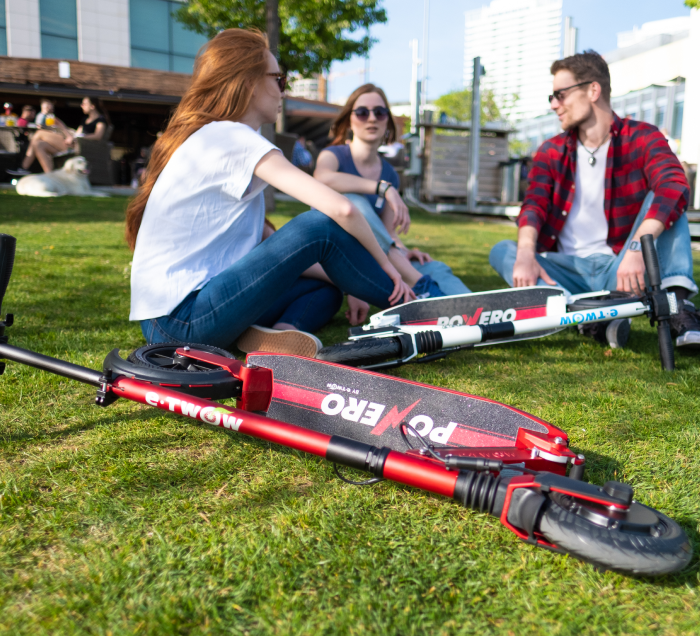
Ride with empathy and understanding of others around you. The road is not just yours, so share it with others. It is always better to travel a little slower than a little faster. Those who are afraid of electric scooters will thank you for it. Therefore, ride wisely and responsibly. Adrenaline does not belong to roads or sidewalks. The most important is to always return home safely without hurting or endangering anybody else. Always ride at a speed that allows you to stop at a distance visible to you.
Behavior behind the wheelIn general, a person’s character manifests in how that person behaves behind a wheel or behind the handlebars of an electric scooter. That is why one can see from a distance who is who, just by seeing how a given person rides. What kind of a person are you?
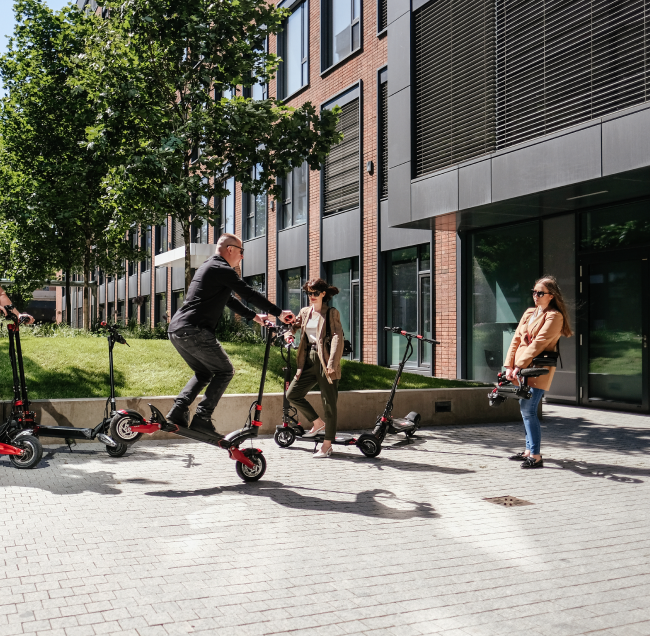
Riding among people
If an electric scooter is travelling on a sidewalk or among people, it should not exceed the walking speed and should not be posing threat to anyone. Pedestrians always enjoy priority. They have the right to the sidewalk. In this case, it is you who is intruding. You have to acknowledge that. Remember it well and respect the right of pedestrians to use the sidewalk as they please. Riders who pass or overtake pedestrians in close proximity are not only arrogant and ruthless, but they also endanger themselves and their surroundings, including the future of electric scooters. We do not want such riders among ourselves and they should not be standing on an electric scooter or even sit behind a steering wheel! Would you enjoy anybody scaring to death your grandmother walking slowly with shopping bags in her hands by such reckless riding? You should realize that electric scooters are completely quiet, even quieter than skates or bikes, while the pedestrians have no reason to get used to scooter riders travelling as fast as cars but on pedestrian sidewalks. Pedestrians have the full right and are entitled not to pay attention to their surroundings, they can stare at their smartphones, walk without paying attention, with headphones on, or to suddenly change their walking direction whenever they remember that they forgot their wallet at home. Remember that the word “sidewalk” is derived from the word “walk”. And not from riding a bicycle or electric scooter.
The law is clear in this matter – electric scooters have nothing to do on sidewalks if they travel faster than at a pedestrian pace. However, let’s not concentrate on what the law says. Let’s talk what common sense has to say about this. In no case I promote or recommend riding on a sidewalk. On the other hand, the condition of our roads or cycling routes, and also the mindset of car drivers, can sometimes simply force you to use a sidewalk. In a hypothetical case of travelling faster than a walking speed, I have prepared a few tips for you on how to do it in the safest possible manner.
Always ride so that you can stop safely before the nearest possible point where a pedestrian may suddenly show up.
These points include (but are not limited to):
- Corner of a building
past which you can not see, as there could be a runner, a small child or a dog appearing from that direction.
- Exits from buildings
The most dangerous being a door that is open or open inwards, so you won’t notice a person opening it until the very last moment.
- Parked cars
you can not see past. A pedestrian, a child or a pet may run from behind a parked car at any time.
- Benches with people sitting on them.
They may not notice you and stretch their legs or stand up and start running fast.
- Underpasses
from which not only a pedestrian may run out, but even a car that does not expect a scooter travelling at your speed.
- Exits from parking areas
especially underground ones. Drivers do not expect someone travelling fast crossing their path, their attention to what is happening around them is low because of challenges of driving a car through the exit.
- Pedestrian crossings
and this also if you have a green light. Beware, a driver cannot anticipate you rushing across the crossing at a higher than pedestrian pace. The most dangerous crossings being those where a driver turns left or right and even has a green light. If someone crashes into you and your scooter in such situation, it is not possible to blame him/her, even if you had a green light.

Riding among cars
Let’s start by saying that you have the right to ride among cars. They must accept you in the same way they accept cyclists, motor scooter riders or bikers. However, this does not change the fact that should something bad happen, you will be at a disadvantage since, unlike a car driver, you will not be protected by metal sheets or airbags. If you want to hit the roads, study the traffic rules carefully, especially if you do not have a driver’s license. Since you are the most endangered road “species”, the last thing you want is to violate any traffic rule or being unsure what the rule says. You must always know without doubts who has a right of way in a given situation and how to behave in traffic. There are plenty available online tests of traffic rules and you can’t go wrong taking them to test yourself whether you know everything.
If you are riding on a road among cars, expect a car to turn right and cross your path without using a turn signal or without waiting for you to overtake it on the right. Not every driver looks in the rear-view mirror, especially in the rear-view mirror on the right side of the car. It is simply how things are and you must foresee such behavior in your own interest.
When you ride next to a car and it starts braking, you should also start braking instead of rejoicing you would be overtaking it. That car always brakes for a reason. A driver may be letting a pedestrian to cross the street at a crossing, or perhaps a dog is running across the road. If you do not slow down as well, you risk bumping into whatever the car is giving priority by braking.
Do not use headphones because you need to hear what is happening around you in traffic. If you can’t manage without listening to music, use headphones that let in street noise.
Give priority to all those who are supposed to have it, but don't rely on you being given priority when you are supposed to have it. Therefore, ride humbly and with sufficient gap so that all reach their destinations safely.
When riding behind a car, always keep sufficient distance – gap in case of any heavy braking. A car in front of you may have better brakes or you may react slowly.
If there are several of you on scooters, do not ride next to each other. It is against the rules but, mostly, against common sense. Less space you leave to others to safely overtake you, the tighter the overtaking maneuver will be.
Watch out for potholes in the road and any open or semi-open drains. Common on the roads are large and deep potholes (especially in the spring), as well as drains with wide holes for water drainage. A wheel of a car or motorbike is big enough not to get stuck in a drain, however a small scooter wheel often gets stuck. Passing through such a hole may result in a fall, which will be even more dangerous with a car travelling behind you. Therefore, do not take any risks in such situation, brake and go around the hole using the curb, or just slow down. By doing so, you will force the car behind you to do the same. It is much better than taking a risk and falling down at a high speed. It is better to have a driver ranting at you (you have the same right to use the road as him/her) than falling down at a speed of 40 km/h or so. If you are not endangering anyone, yet a driver starts shouting at you only because you slowed him/her down for your own safety, calmly explain to him/her that s/he should thank you for travelling on a scooter. If not on a scooter, you would be sitting in a car and the morning traffic jam would be even worse, not speaking about the environmental impact. If that driver was standing on a scooter too, chances are s/he would be arriving to work earlier and in a better mood.
If you overtake stationary cars or travel alongside parked cars on a sidewalk, keep in mind that someone may open the door on a given car at any time without looking in the rear-view mirror. This often happens in a standing traffic jam when children decide walk to the school because it is faster. Suddenly, the door opens right in front of you and you have no chance to stop in time. Meaning, you should maintain maximum possible distance from cars and, in particular, you should not ride unnecessarily fast. You will probably arrive to your destination much earlier than the drivers you are overtaking anyway.
Slow down if you see a bus standing at a bus stop or next to a sidewalk. You never know who may run out from behind it. And since you can’t be heard, that person may not realize what a stupid thing is to run out in front of a bus.
If you are approaching a pedestrian crossing while travelling on a road, always slow down and be prepared to brake even if there is nobody walking across the street. For instance, there could be some other scooter rider that decides to cross the street at the very last moment, being in a hurry and not thinking about consequences. When you ride next to a car and it brakes, always brake with it. That car may just be giving priority to somebody you can’t see looking from your angle. Many accidents occur when a car in the left lane brakes before the crossing and allows a pedestrian to cross the street while a car in the right lane does not realize what is happening and continues going forward. Such pedestrian then crosses its path at the last moment as they did not see each other because of the car in the left lane. The same misfortune may happen to you on a scooter. Therefore, always think about why it is that someone is braking.

Corners, exits, ways out, turns
The following is one of the most overlooked rules of safe riding on an electric scooter. Always ride so that you can stop safely before the nearest point where a sudden obstacle may possibly appear. This applies to any riding, at any place, be it somewhere in a field, in a city, or outside it. Where you can not see, that is the point you must be able to stop before at any time. Typical points: street corners, exit doors from apartment buildings, exits from underground parking garages, cars exiting a car park through an underpass or between two buildings, exits from commercial premises, from behind a parked van etc.
Typical spots where it is always better to slow down
For illustration purposes, let’s say that the scooter travels on a curb or on a sidewalk:

- Exit from a parking area, especially the underground one. The exiting driver may be fighting his own clutch while going uphill, not expecting any small and fast scooter crossing his path. Therefore, it is better to brake a little and be prepared for full braking.
- Corner of a building I can’t see past. Will a runner appear out of nowhere? Or a dog that escaped the owner? I always travel at a speed that allows me to stop at a distance I can actually see.
- My view is blocked by a corner of a building, which is why I slow down even when I am travelling on the road and turning right. If I am on the road, I may have priority based on the right-hand rule. However, I do not rely on it and I only use this right of way only when I am sure that other drivers not only see me, but are also aware of me.
- Exit from a building. A person rushing to a meeting may run out an exit at any time, especially when you ride on the sidewalk and not on the road. If I am on a sidewalk, I definitely slow down to a pedestrian pace.
- Until I see past the bend, I preventively slow down. I only start accelerating when I see through the whole bend. What if a broken car has been left standing there?
- A tree is blocking my view through the bend. I travel slowly through the whole bend until I can see enough road in front of me.
- I always slow down near stationary cars. Someone in a standing car may open the door abruptly whether on the side of the sidewalk or the road, without checking the rear-view mirror first. Specifically on the sidewalk side, no one can realistically expect a fast-moving electric scooter travelling there.
Surface
In this chapter, by surface I mean its condition in terms of build quality – not weather conditions. I discuss weather conditions in the Wet or dry surface section. The surface itself, on which you ride, has a major impact on riding safety. I write about riding on an unpaved surface here. But what about other, common urban dangers?
Broken roads / sidewalks / potholes and drains
It is on what type your scooter is. Large scooters fitted with high-quality suspension do not have a problem with a surface like that, they are able to handle all common potholes. If you have a small scooter with weak suspension system and fitted with solid or small wheels, and provided you do not endanger anyone by doing so, it is recommended to “zig-zag” and go around all potholes and bumps. You may travel slower, but you reduce the risk of falling down and you also spare your scooter. When passing through a surface like that can’t be avoided and you know that you can’t brake to a stop in time, you still have several options at your disposal to avoid troubles.
If a hole/bump is a short one and not too high, you may jump over it. Yes, with some practice it is quite easy to do it on a scooter. An experienced rider is able to lift a light model into the air by 15 cm or so, which is plenty enough to jump over a big obstacle. However, you must have sufficient speed and practice to be able to do this, otherwise if you fail to jump in time or far enough, you may make it worse and you may end up falling down nastily. Therefore, I recommend that only experienced riders jump over obstacles. With little practice, it is possible to jump without problems both over the potholes and speed bumps. However, keep in mind that we are talking about a maneuver in a crisis situation and in an attempt to prevent a fall. Most scooters are not built for making regular jumps or doing stunts.
If you do not feel like jumping or when you travel too slow, it is best to brake hard until the very last moment. Release the brake just before hitting the obstacle and lighten the load acting on the front wheel by pulling on the handlebars and leaning back. This not only reduces the impact force on the front wheel but also allows you to ride through the obstacle. It similarly reduces the risk of scooter tipping over its front wheel, ejecting you into the air. Thanks to previous braking, the impact on the obstacle will be much weaker, meaning your chances will be much better when reacting like this. When you realize that nothing is going to help and you start flying forward, it’s time to let the scooter go, allow it to continue its own course and try to land on your feet, or at least with yours hands first, softening your fall. It is better to have your palms get the worst of it (ideally in gloves) than to injure your head or back.
Curbs
If you do not have a really good chassis and wheels, always get off your scooter and carry the scooter over the curb. Even low curbs may have sharp edges and damage your tire, wheel suspension, chassis, etc. In the worst case, they may cause you to fall down. If you are sure that you can get on the curb while riding, it is always worth lightening the front wheel by moving your weight backwards and, possibly, by slightly pulling the handlebars upwards. This will reduce the impact on the front wheel. When the front wheel is already up on the curb, quickly move your weight forwards to help the rear wheel. If your calculations are wrong and you have not sufficiently reduced the load on the front wheel, it will get stuck and the scooter will tip over it, making your flying forward with it. At that point, it is once again better to let the scooter go and try to soften your fall as much as possible, ideally to land back on your feet. If you are unable to do that, put your hands in front of you and slow down your fall with your palms hitting the ground first. In any case, passing through curbs is generally not recommended as it puts too much strain on the steering rod, with most scooters not designed for it. Sooner or later you risk damaging your scooter.
Ground clearance
Another thing one must pay attention to is ground clearance, especially with small scooters. Even small curbs can bring unpleasant falls. A scooter with small ground clearance often scratches the curb with the bottom of its deck while passing through it. This almost always leads to an unexpected and immediate deceleration of the scooter and a huge risk of falling down. This may also happen to you when going down the curb, which is all the more dangerous as any fall will logically point towards the road and in front of passing cars, if any, being also harder since the scooter is travelling down. In addition to ground clearance, pay attention to lower mounting of the rear shock absorber, which is installed at a very low height on some models. You may think that the scooter’s ground clearance is sufficient. However, because of the low mounting of the shock absorber, it may not be even half of what you think it is. Even if you succeed in crossing a curb with the front wheel, your scooter may hit it with the shock absorber’s lower mount, resulting in a lot of damage to your scooter. Please note that the heavier the rider, the lower the ground clearance on the sprung models. It may be significantly lower when the scooter is under load than when it is parked in a stand.
Cobblestones
A popular building element used in constructing roads and sidewalks. A sworn enemy of scooter suspension systems and solid wheels. They are very slippery when wet, much more than ordinary asphalt or concrete. The only way is to slow down, especially with poorly sprung light scooters fitted with solid wheels. If your scooter does not have any suspension, it is best to stop and push the scooter next to you while on cobblestones. Better than falling down or destroying your scooter.
White lines
Even a slightly misty or damp white paint on a road can behave like ice. Whether those are center lines, pedestrian crossings, curbs – they will always be very slippery. If you are taking a turn and you see that you will have to cross such while line while it is wet, the best thing to do is to straighten up your scooter, cross the line while travelling straight and without leaning the scooter, only to continue cornering after passing the line.
Gravel and dust
Be very careful when you see gravel on the road, particularly after winter. It is extremely slippery, especially in a bend. Also, it is very difficult to brake on gravel or dust. If a car overtakes you while passing through gravel, watch out for any small rocks flying off the wheels. Your should wear bicycle goggles as a precaution to protect your eyesight. If you see any gravel in a bend, always slow down before entering it and behave as if there was ice on the road. It is always better to travel a little slower than a little faster and fall down in-between cars.
Do not underestimate servicing
Scooter and its condition
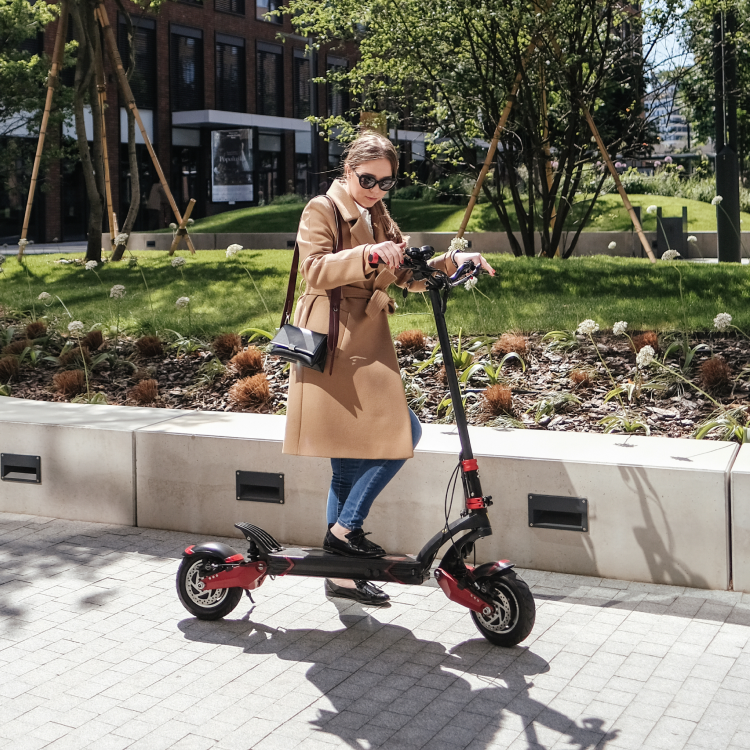
Safety on electric scooter does not rely on active elements only, such as your specific riding technique or anticipation. The technical condition of your scooter, its correct setup and suitability for the given conditions play a major role as well.
Suitability for "given mission"
Not every scooter is suitable for all conditions. And even if it can handle the given conditions, it does not mean that it has been designed or suitable for them. You can use a small convertible car to travel to Northern Poland on broken county roads and then drive there in easy off-road terrain somewhere in the woods. However, it does not change the fact that such a car has not been designed for it, that its chassis has not been built for it and that the driver will not arrive to the destination relaxed and fully concentrated. Vice versa, you can take a large off-road vehicle and travel around the city with it. But it will be a problem for you to park it and maneuver it in narrow city center streets.
Therefore, it is necessary to establish at the very beginning, what your scooter is suitable for and what lies beyond its capabilities. The greatest problem arises with small, light scooters, which are overestimated by their owners and too much is expected from them. Although they can handle long routes on bad roads, it does not necessarily mean that they are suitable for that. In the long term, they suffer from strong vibrations and they operate at the limit or past the limit of their capabilities. If that is your case, you are endangering not only the scooter (which you are gradually but persistently destroying) but your safety in particular. Your body suffers during long rides on a poorly sprung scooter and your ability to concentrate gradually deteriorates. Constant vibrations, avoiding potholes, small wheels or weak brakes slowly contribute to the fact that your ride gradually changes from joy to suffering. Such “abuse” of your scooter has a huge impact on its technical condition and, therefore, on your safety.
I will start with the range claimed by the manufacturer. These numbers apply to optimal conditions. Usually, to a rider weighing about 70 kg, with no wind and temperature of 25°C, at a speed of 20 km/h and on a straight and even road. Of course, this is far from real-life conditions and the actual range in a city is usually 30-40% shorter than claimed by the manufacturer. If you already have a scooter, then you know it well based on your practical experience. What is important, however, is that Li-Ion batteries that are used in the vast majority of scooters are not built to regularly operate in borderline situations. This mostly means discharging the battery below roughly 25% of its capacity, which rapidly shortens its serviceable life. Ideally, it is best not to let the battery capacity unnecessarily fall below about 30%. The occasional full discharge will not have any significant impact in the long run, but it is certainly not advisable to do it regularly. Another good reason why I recommend looking for a higher capacity battery than what you think you need is the fact that over time the batteries lose some of their capacity. The usual decrease in capacity is about 20% after some 200 full cycles. That is why the same extra 20% capacity will significantly extend the useful serviceable life of your battery as the need to have it replaced will come much later.
A healthy formula I recommend when choosing a scooter is to look for the one with claimed range that is approximately two to three times longer than your planned daily trips. For instance, if you travel 8 km to work, you need to ride 16 km daily. Therefore, I would be looking for a scooter with a claimed range of at least 32 km, ideally 48 km. This will ensure not only a significantly longer battery life, but you will be also riding with peace of mind, knowing that you have sufficient extra range for any unplanned changes to your route or any additional meetings. And should you wish to go on a joyful weekend trip somewhere, you won’t have to limit yourself. If you regularly leave the house with a fully charged scooter and return with a capacity below 30-40%, although the scooter should be showing much higher values based on the actual mileage, this suggests that you are unnecessarily overloading your scooter and, especially, its battery.
Choose the right modelThe scooter’s suitability for your mission is not determined by battery only. There are other parameters, such as the size and type of wheels and the method of suspension.
Scooters with 8-inch wheels or smaller are suitable for a so-called last kilometer solution – from a public transport stop or from a parking lot. They are usually designed for this purpose and are very light and compact. Scooters with wheels up to 9 inches are sufficient for most routes in a city, especially if they are partially or fully sprung. If you have wheels over 9 inches and a fully sprung chassis, your scooter will be also suitable for long trips. It is a good thing to realize that the longer the planned daily range and the more demanding the terrain, the more comfortable your scooter needs to be. The ability to remain comfortable during the whole trip is also important from the viewpoint of safety.
Recommendations for individual combinations:
The impact of chassis suspension and wheel type on riding safety is huge. The presence of a sprung chassis will be a deciding factor in borderline situations, between falling down from the scooter or being able to continue riding while lamenting over the situation. It is quite simple, the higher the speed, the smaller the wheels and the worse the suspension – the greater the risk for you while riding. Therefore, if your goal is to ride safely, you must not forget this simple equation. If you want to feel safe on an unsprung scooter with small wheels, you will have to ride very slowly.
If your mission also includes riding outside paved areas, such as on a path in a park, a field road, some off-road terrain, or perhaps on a very broken road, I would consider chassis suspension as mandatory. The worse the conditions, the higher quality suspension and the bigger wheels are needed. As for suspension quality, a standard spring is a basic solution that is plenty enough for a city. However, it will not be sufficient for riding safely at high speeds or off-road terrain. In such case, it is necessary to reach for models fitted with torsional shock absorbers or, even better, with a spring combined with oil or pneumatic shock absorber (naturally, on both wheels). The springless shock absorbers are among the most comfortable to ride but they are not suitable for absorbing stronger shocks or for off-road trips. When riding “at the limit”, the shock absorbers without additional spring can be easily damaged.
I definitely do not recommend riding outside paved areas on narrow wheels smaller than 9 inches and without proper chassis suspension. It will be neither a pleasant nor safe experience.
Performance vs safetyThe performance has no direct relation to safety and certainly does not mean that a powerful scooter is less safe.
However, it has a great impact on reliability. The more powerful scooters tend to be more reliable because their electrical components are under less stress (percentage-wise) compared to less powerful scooters facing the same situation. When it comes to performance, the rule is that it is better to have extra untapped power at hand than to constantly “squeeze every last drop” out of your scooter. If you ride consistently at the scooter’s limit and at its full motor capacity, you may expect the motor, controller and battery to overheat, which further reduces their serviceable life. If you travel equally fast on a scooter with output higher by 200 W, the scooter will not be required to use its full power and its components will therefore last longer. It does not relate directly to safety, but I have summarized my performance recommendations in the following table:
Performance recommendations:
PerformanceWhen it comes to performance, having more power available than actually needed is perfectly fine. However, having insufficient power will surely spoil your riding experience.
Therefore, if your budget allows it, I recommend opting for a more powerful model that will serve you well for many years. The lack of performance can be dangerous. For instance, when riding on a road among cars, especially up a steeper incline. Such scooter will start slowing down even with output set to maximum, which may surprise car drivers and they may start overtaking you at the last moment. Everything that is done at the last moment is usually dangerous.
Customers who bought a less powerful model often return to us after 6 to 12 months, saying that it was a mistake. Then they buy a stronger model. At first, the performance seemed fine to them. But as soon as they got used to their scooter and began using it more and for longer trips, they discovered that having more power simply can’t hurt. By buying a scooter and later selling it, it loses its value. Therefore, it makes more financial sense to buy a slightly stronger model straight away.

There are only a handful waterproof scooters on the market and even fewer scooters that come with an official IP certificate. Riding on a wet road or in the rain is generally a bad idea from the viewpoint of safety, which fact I discuss here. Some scooters can survive running water. However, almost none of them can survive immersion or water spraying under pressure. Therefore, you should be aware that your scooter is most likely not suitable for riding in the rain or on a wet road. Your wheels have much worse grip and, in particular, you risk permanent damage to electronic components that may not show up immediately after taking a long trip in the rain. As it often happens, water penetrates into electronic components in a tiny amount, which increases humidity and initiates the oxidation process. This process may take weeks or even months before manifesting itself as a malfunction.
The most dangerous is riding through puddles, and this because when travelling at speed one often can’t see what lies on the bottom. There could be a deep hole hiding there or stuck leaves causing skidding. However, this may also cause troubles when it comes to electronic components. When you go through a puddle, we are no longer talking running water but rather water ejected under pressure that can easily penetrate into the scooter through seals. At the same time, this involves immersion, for which even scooters with enhanced water resistance are not certified.
Therefore, the rule is that riding through a puddle is a very bad idea with all electric scooters. Riding in the rain or just after it stopped raining is not appropriate from the viewpoint of riding safety and, on most scooters, also from the viewpoint of long-term reliability and violation of warranty conditions. Therefore, it is generally a good recommendation to avoid riding on a wet road and, if not possible, to ride much slower and always avoiding puddles. Please note that electronic circuits and the battery in particular are the most expensive components of the entire electric scooter and any water damage is not covered by warranty. Even with models offering enhanced water resistance, the manufacturers will reject such claims on the grounds that this was no running water but rather water spraying under pressure or immersion into water. The battery is usually worth about a third of the scooter’s full price, so its replacement is usually a pretty expensive matter. Interestingly, the malfunction caused by water penetration into the scooter body may manifest itself a few weeks after you actually passed through a puddle with your scooter. This can be particularly dangerous with models fitted with an electromagnetic or regenerative brake. If the electronic circuits shut down completely while riding, these brakes will stop working. In extreme cases, the damage to electronic components may result in spontaneous braking while riding. However, you will not be expecting it because you rode through those puddles last week and you have long forgotten that incident.
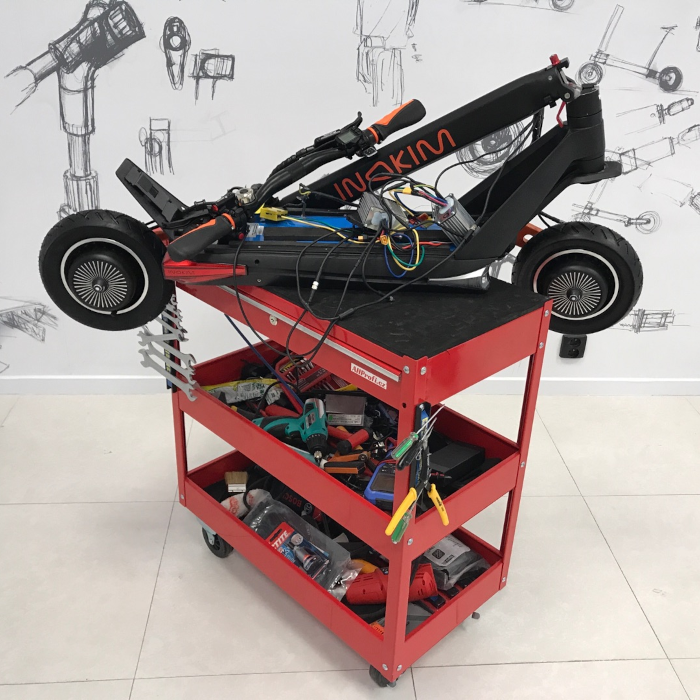
Regular servicing
If you want to be a responsible scooter rider, learn to inspect your machine regularly. Regardless of whether yours is a cheap scooter costing a few hundred euros or a machine on steroids for thousands of euros. All scooters need regular servicing. You do not have to take your scooter to a service shop. You can perform all basic checks and repairs in a few minutes free of charge in the comfort of your home. However, if you are not entirely sure about something, you can stop at one of our stores. We always provide free Safety checks, since we value safety more than our profits. However, this is not necessary as taking care of a scooter is no rocket science and you can do it without problems at home.
After a while, it will take less than 5 minutes. Once done, go for a short test ride, check the charging and you’re finished. This list is also used by our technicians during safety check, in order not to forget anything. You can download it here and print it, so that you don’t forget anything while checking your scooter. As you can see, you can perform all checks by yourself. However, should you encounter any problems, we recommend that you contact our service shop. One day, this regular and fast home servicing can be the difference between an unpleasant fall and a comfortable ride. Therefore, do not underestimate it. During the riding season you can, for instance, set a weekly reminder on your phone.
In addition to regular “domestic” safety service, at least once a year we recommend performing a more professional, in-depth service and the so-called prophylactics. As part of this service, we also check the battery, electronic components and the “bowels” of your scooter. We perform a thorough test ride and issue a service inspection report. It is like a service log book we all have in our cars. It may increase the value of your scooter when you sell it, especially when the log shows regular servicing. When we discover any deficiencies, we inform you about them by phone and you then decide what to do next.
Safety and serviceThe rule is that if you are not sure about anything, it is better to ask or visit the service shop as when it comes to safety, no question is stupid question, and no inspection is unnecessary inspection.
Do not forget
Safety equipment
If they gave me 1 euro for each scooter rider I see without wearing a helmet and 50 cents for each rider without gloves, it would probably be enough for a decent life without having to work. I don’t truly understand the habit of riding without a helmet or gloves. The only possible explanation for this is that riders are not aware of potential consequences. Electric scooters are no toys for children and reach fast speeds. Much faster speeds than bicycles, in fact. But meeting a cyclist without a helmet and gloves is quite unusual today. So, why is it that scooter riders feel safer than cyclists or skaters?
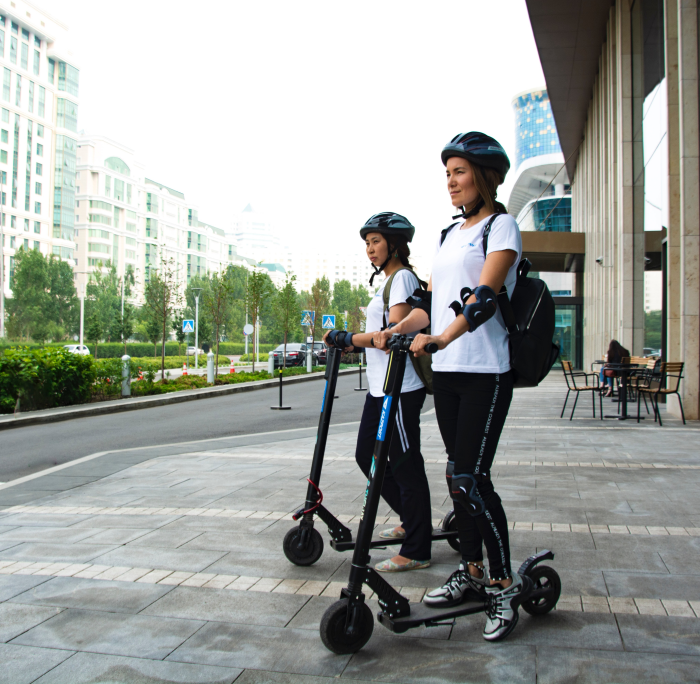
Apparently, this is due to the “novelty” factor of this mode of transport, as well as due to the fact that many scooter riders are in fact beginners who are not fond of riding bicycles. They do not own a scooter because they are electromobility enthusiasts but simply because it is the most practical method of travelling quickly around the city. Last time they rode a bicycle was during their childhood and they have probably long forgotten how a broken knee hurts or how large skin abrasion looks on a leg. They have a false idea of their personal safety because it has been a while since something bad happened to them. They forgot that potential injuries apply to anybody riding on anything, whether on a bicycle, skateboard or electric scooter. Even the skiers on winter slopes began to wear helmets en masse. Still, the scooter riders seem to ignore the fact that they could end up in a hospital at any time without doing anything wrong on their part, simply because a city is full of dangers and other road users who are much better protected and often less vigilant. A habit is enough to get you into trouble – such as a bend that you take every day at 25 km/h but you do not know that there was an accident there yesterday and a few liters of leaked oil remain on the road, or perhaps some gravel spilled out of a truck travelling to the construction site – and you can no longer prevent falling down from your scooter. Or simply someone won’t respect your right of way, a dog may suddenly cross your path, or some other scooter rider may crash into you while looking at a woman wearing a short skirt. There could be dozens of situations along your standard route, in which you will not have everything under control (which is not your fault), and just one of them will be enough for you to discover that you no longer enjoy control over your scooter but are rather controlled by the unforgiving laws of physics.
This is not to scare you. Those are facts. In our service shop, I’ve seen too many scooters damaged by fall to be able to pretend that accidents do not happen and that they cannot happen to me or to you. I am not trying to discourage you, simply because if you act responsibly, your chances of never experiencing a fall are big. However, if there is something you can do with little effort and which increases your chances of walking out unscathed after falling down from your scooter, it would be extremely irresponsible towards yourself and your loved ones not to take those few simple steps.
How to protect yourself?How to increase your chances with minimum efforts and energy? By using proper safety equipment.
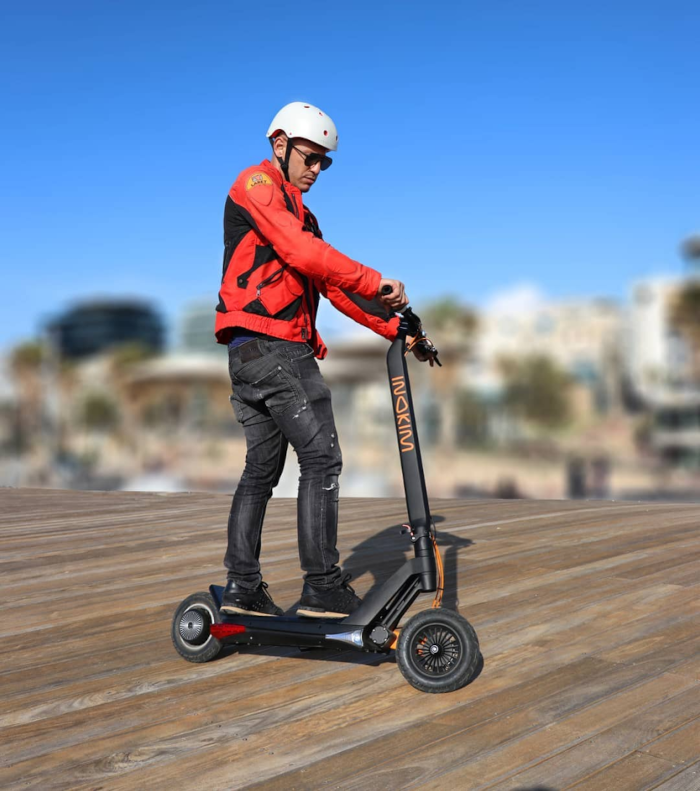
Helmet
Any head injury is dangerous. The cervical spine is not strong enough to prevent head contact with the ground in the event of a fall, and this not even at low speeds. Therefore, if you fall, the impact on the head is almost certain. Meaning, wearing a helmet should be natural and without any doubts. You should not take any trip without it, not even 500 meters.
A frequent argument is that a helmet ruins one’s hair. But hitting a ground or curb will definitely ruin your hair even more. Not to mention that when riding at about 20 km/h, your hair will be ruined by the wind, so maybe a helmet will actually protect your hair style.
There are hundreds of them on the market to choose from and you can match it to the color of your scooter. By wearing such helmet, you risk a blow to the chin or face as it does not protect the lower part of the head. Nevertheless, it is an excellent solution for a city or for trips where you won’t be breaking any speed records. The so-called smart helmets with built-in lights and even turn signals operated by a remote control on the handlebars are an excellent solution. Some of them even have a Bluetooth module allowing listening to music while making sure that you continue to hear outside noises.
If you usually ride faster, outside a city or even in the field, you have nothing to think about and should get an integral helmet designed for downhill or even for motorcycle riders. The helmets for motorcycle riders must meet certain stringent standards and you can buy them in every biker shop. These helmets protect the whole head and are much safer. Wearing such helmet will certainly not look out of place, especially if you have a powerful scooter. On the contrary, it will go beautifully with the powerful machine you ride.
Always fasten the helmet under your chin properly before riding. Keep the length of your strap set correctly so that it does not move freely under your chin but neither strangles you. There is nothing worse than wearing a helmet that falls off your head in an accident. It may protect your head during the first impact, but if it falls off your head afterwards and, for instance, you keep rolling down the road, it will not protect you from any subsequent impacts. Therefore, always keep it firmly attached to your head so that it is not able to move freely to the sides.
One final advice. If you are too lazy to wash the inside of the helmet once in a while, there are several antibacterial sprays available on the market. Just spray the substance into the helmet from time to time and the helmet will continue to smell like new.
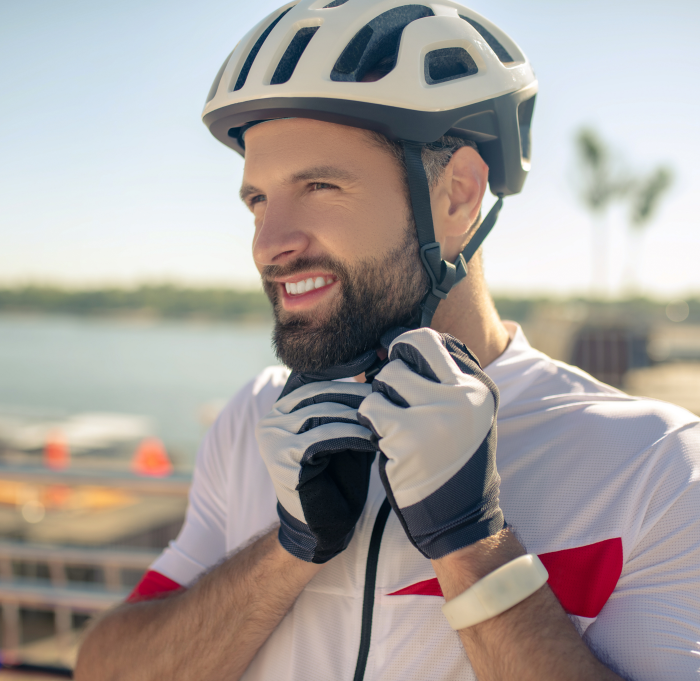
Gloves
Many of our customers laugh at gloves, even those who actually wear a helmet. Allegedly, these gloves don’t look good and they don’t go with a scooter, making the rider looking ridiculous. For me, a ridiculous person is the one who subordinates his/her appearance to what others think rather to his/her own safety. Our body responds to a fall instinctively and identically to what we all learned when we were one year old and fell for the first time. Subconsciously, we stretch our hands in front of us to soften the fall and, at lower speeds, to protect our head from impact. Therefore, our hands are often the first part of the body coming into contact with the road or sidewalk, often at speeds exceeding 20 km/h. I doubt you would try rubbing your hands against the road full of stones and dust while driving a car.
The best gloves are those that have reinforced padding in the palm area to help cushion the fall. If you ride faster or in off-road terrain, wearing motorcycle gloves is no shame. On the contrary, they simply go with powerful machines, just like a helmet. Since most falls end up with our palms touching the ground first, the gloves may be perforated on the back side so that your hands do not get too hot.
If you are buying cycling gloves, buy the ones that have additional loops in between the fingers. They are used to allow easy removal of gloves after riding. Just insert your other hand’s finger into the loop and start pulling – the glove is easily removed in a few seconds.
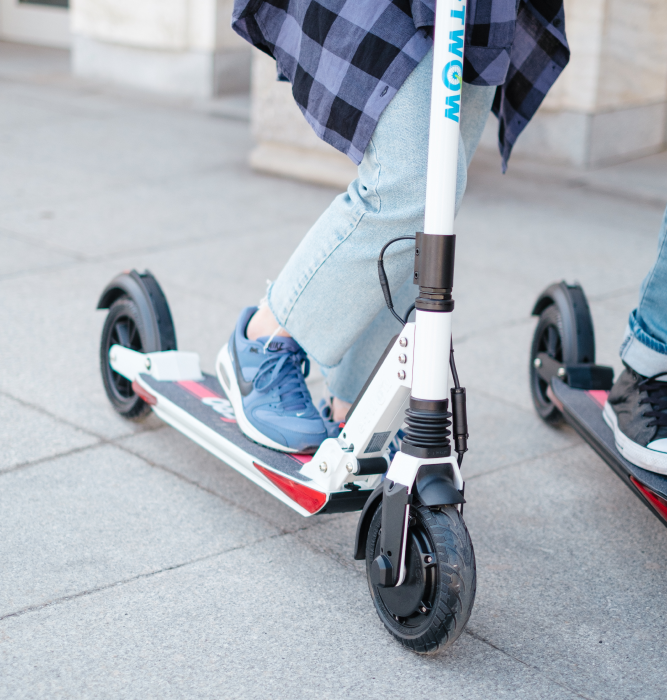
Footwear
If you wish to ride your scooter safely, then you know that apart from hands, the only real contact between the rider and the scooter are the feet. The handlebars serve for steering only, not to support rider’s weight on the scooter during heavy braking or acceleration. That is why proper footwear is what keeps you on your scooter in every situation. If your foot moves freely inside your shoe, it is as if you put a lot of oil on the seat of your bike or motorcycle and then start slipping on it each time you brake or take a turn. Absurd, right?
You need sturdy closed shoes on a scooter that fit your feet well and without your feet moving sideways, forwards or backwards inside the shoes. The shoes must have a good outsole gripping to the scooter deck without slipping. A hard shoe tip is an advantage, which may help if you have to jump off the scooter and trip over while doing so.
If you have a bigger shoe than you need, your foot moves a little forward inside the shoe each time you brake and your toe hits the tip of the shoe, which both reduces your stability and can lead to minor nail injuries or even ingrown toenail. Open shoes, Crocs and similar footwear do not belong on a scooter. You better throw such shoes to your backpack. When you arrive to work you can change to your favorite shoes.
Protectors
Adapt your safety equipment to the speeds you are riding at and to your riding style. If you ride faster than 40 km/h or in off-road terrain, it is time to start thinking about further improving your passive protection. Suitable equipment includes knee, elbow and spine protectors, or possibly the so-called “full body armor jacket”. All this can be bought in a cycling shop or in a shop serving bikers.
If you do not wish to look like just returning from a downhill race while travelling around the city, you may try wearing more discreet equipment in the form of moto (Kevlar) jeans and reinforced jacket or vest. There are dozens of them available on the market, they look great and one can not see that they are in fact reinforced and fitted with protectors. They will be invaluable should you ever fall. You would not believe what special materials, such as Kevlar used to make bulletproof vests, are capable of withstanding. They are unobtrusive and can protect your health.
The same materials are used to make normal-looking motorcycle boots that look like ordinary, slightly taller sneakers but in fact feature special (often metal) reinforcements protecting your ankles, heels and toe.
ProtectorsThis way, you can look trendy and, at the same time, be excellently protected should you fall, even at fast speeds.
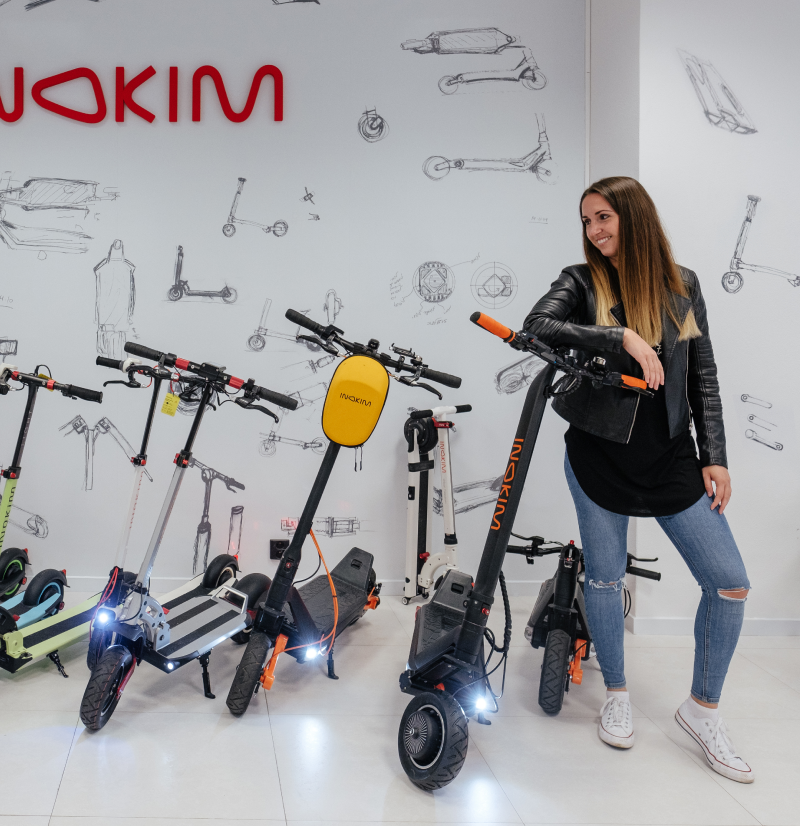
Turn signals and lights
The lights on most scooters serve to make you better visible in poor visibility, such as at dusk and at night. However, they are not primarily intended for you to see well in front of you and they are definitely insufficient for travelling at higher speeds. As for lights, the rule is that there are never enough of them and you can’t go wrong with installing additional lights. Suitable for this purpose are strong bicycle lights fitted with their own battery, which you can attach to your handlebars. If you are serious about riding at night, feel free to use two lights, one on the left side and the other on the right side of handlebars. If you don’t have enough space on handlebars (for instance if you have a smartphone holder installed there), keep in mind that you have an entire steering rod at your disposal, to which additional lights can be easily fitted.
Ideally, you may use a modern smart helmet with built-in lights, as your head represents the highest point and it is best seen from a distance, even over cars near you. We offer such helmets and they come not only with lights but also turn signals controlled on handlebars and even with Bluetooth interface allowing you to make phone calls or listen to music while also hearing the surrounding sounds.
The turn signals are definitely a good accessory, particularly for riding in a city. There are several solutions, but I consider the turn signals built into the helmet to be the best option as their flashing is visible from the front, back and side and they are controlled by remote control installed directly on the scooter’s handlebars. Naturally, there are other options. But these have turn signals usually placed unsuitably or do not provide sufficient visibility.
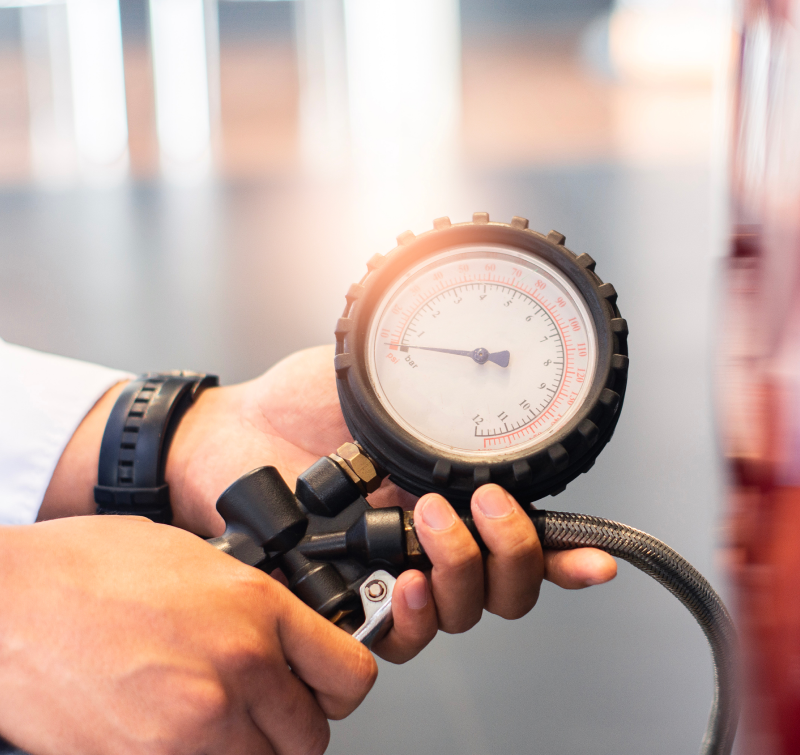
Compressor
A compressor with pressure gauge forms part of safety equipment as wrong tire pressure is dangerous. If the pressure is wrong, you risk punctures, longer braking distance and tire damage. With a compressor equipped with its own accumulator, you will establish a good habit of regularly checking your tire pressure. A compressor like that fits into a small bag that you can carry on the scooter. You will thus be sure that even on a longer trip you will not have to push your scooter home with flat tires.
Air changes its volume based on temperature. Therefore, if you inflate a tire at home and go for a ride in the winter, the tire pressure will drop significantly when the tire cools down due to the cold environment. And vice versa, it will go up significantly in the summer due to higher air temperature and scorching asphalt. These pressure differences can range in tens of percent and may result in longer braking distances. Therefore, it is important to check your tire pressure more often, especially in the hot summer and in the winter.
Everything you need to know
Charging and electronics
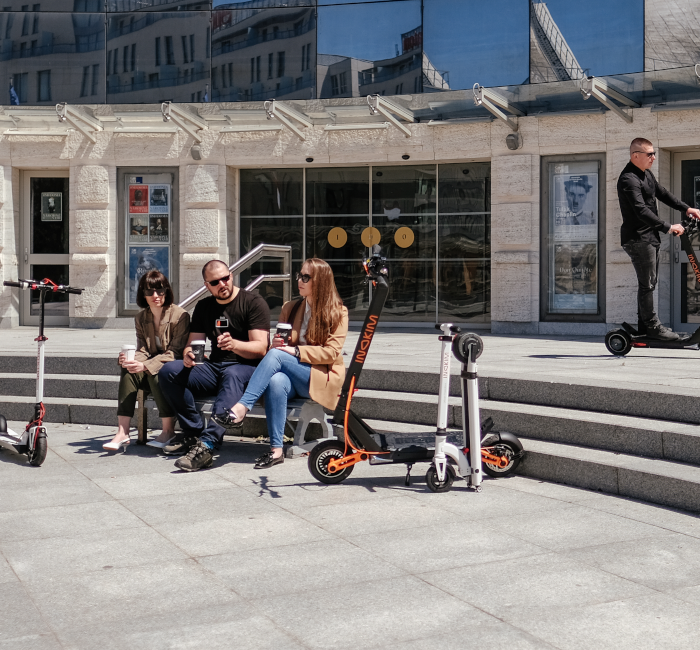
Battery
The most frequently used batteries in electric scooters are Li-Ion batteries that are excellent for this purpose thanks to their maintenance-free nature and high density of stored electricity per kilogram of battery’s weight. In general, those are very safe batteries that have proven themselves over time as the first Li-Ion battery was manufactured by Sony back in 1991. In addition to high density of stored energy, they also exhibit very low self-discharging and minimal memory effect. They do not need any formatting before first use and offer a fairly decent serviceable life, provided you take care of them properly. In addition to electric scooters, you can find them used almost everywhere, which is thanks to their high energy density, especially where low weight matters. From smart watches, through smartphones, laptops, cordless vacuum cleaners and other household appliances, to the state-of-the-art electric cars of all brands, such as Tesla, Škoda, Porsche or Mercedes. These batteries are also common in Boeing and Airbus transport aircraft.
Naturally, these batteries also have disadvantages. For instance, as the battery ages, it gradually loses capacity even when not being used. This aging accelerates at higher temperatures. The Li-Ion batteries are extremely negatively affected when discharged fully or by conditions approaching a nearly full discharge. It is likewise not appropriate to store a scooter over long periods with its battery fully charged at 100%. Recycling these batteries is expensive and often costs more than the raw materials obtained by recycling. From the viewpoint of safety, their biggest disadvantage is their instability when used incorrectly (short circuit or incorrect charging, for example at higher voltage), which is manifested by a sharp rise in temperature and the subsequent fire.

When used properly, Li-Ion batteries rank among safer ones. However, this does not mean that every device containing them is safe in all conditions. Just remember the well-known case involving the Samsung Galaxy Note 7 smartphone, which had to be recalled by the manufacturer from the global market because of the poor design and placement of the Li-Ion battery. Few people know that even the Boeing 787 Dreamliner airplane had problems with Li-Ion batteries that later had to be all replaced.
To better understand why Li-Ion batteries can be dangerous, one must look inside them. Removing the protective film from commonly used batteries reveals something like this:
As you can see, the battery in an electric scooter is actually not a single battery. It rather consists of a large number of properly connected smaller batteries. The higher the battery’s voltage and capacity, the higher number of these “battery cells” your scooter has. Each Li-Ion cell has a nominal voltage of 3.6 - 3.8 V and the battery’s total voltage and capacity depend on how many of the cells are connected in parallel and how many in series. The danger comes with the fact that a battery can be compared to a chain. It is only as safe as its weakest link. The higher the total stored energy (voltage times capacity), the more cells it contains and the more likely sources of problems.
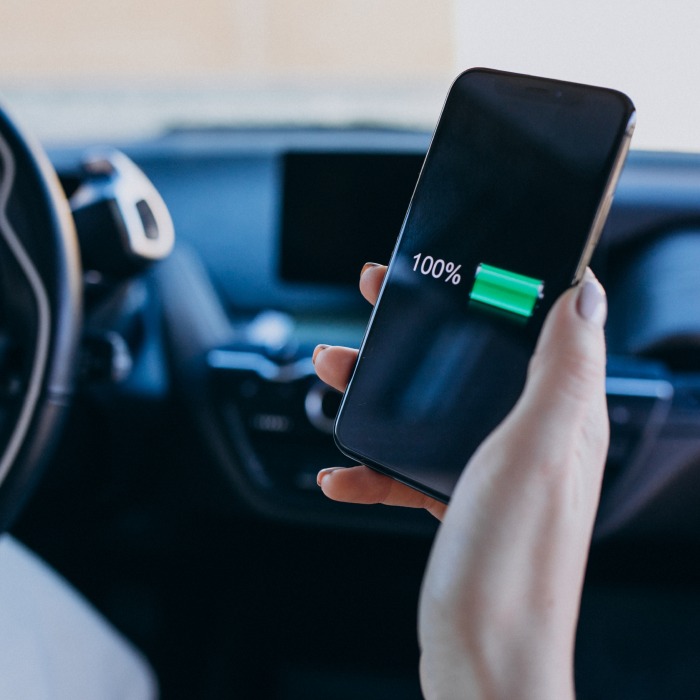
Charging
We charge Li-ion batteries ideally at room temperature, however never at temperatures below 0°C or above 45°C. And although operating a Li-Ion battery in freezing temperatures down to -20°C is not prohibited by itself, charging at these low temperatures does damage the battery. Also, do not charge your battery shortly after finishing a trip. The battery must first be allowed to cool down to the optimal temperature. After a ride, the battery is quite hot due to intensive energy offtake. To start charging it instantly could damage it.
In addition to cells, each battery contains the so-called BMS (Battery Management System) – a system that controls the charging and discharging of individual battery parts (segments) so that they are discharged and charged evenly. Most BMSs do not control separate charging and discharging of each cell. That would require more complicated design and cabling. Instead, they control smaller parts, the so-called segments, which group several cells together. Therefore, not even the BMS knows the exact condition of each cell, only the average for the given segment. If, for instance, any segment got mistakenly overcharged by BMS, it would have a higher temperature than other segments. This segment would then age faster, its capacity would be getting lower, making overcharging even worse.
This is a very theoretical case and does not happen too often in practice. As the production of Li-Ion batteries is no longer in its infancy, the quality of batteries themselves is improving and such incidents get scarcer. However, it does not mean that no Li-Ion batteries fail or that they cannot fail right inside your scooter. The fact is that they do fail. However, that is seldom caused by a manufacturing defect. Usually, it is caused by incorrect charging or mechanical damage.
DangerThe most common reason behind a dangerous exothermic failure of a Li-Ion battery in electric scooters is the use of wrong changer.
The BMS cannot handle higher than expected voltage used by the charger, which leads to a sharp increase in temperatures during charging. This results in the rapid ageing of cells, uneven balancing of battery segments and the subsequent battery destruction or fire. With high energy capacity batteries used in electric scooters, this does not result in a small house fire but rather in a dangerous, difficult-to-extinguish fire with high-temperature flames that are easily able to set any nearby furniture on fire and consequently the entire apartment or the whole apartment building in the worst case.
Therefore, please only use original chargers, even if they cost 100% more than their cheap alternatives sold by some suspicious e-shop. The difference in price is not caused by the manufacturer’s desire for profit (the manufacturer of super cheap chargers has the same desire), but by the quality of the product and extensive testing of the charger-battery combination to minimize the risk of failure.
It is also recommended to connect the charger to the mains first and only then to the scooter’s charging port. For instance, if a short circuit occurs in the charger, you certainly do not want it to be connected to your new scooter at that moment and damage your battery. As a standard, chargers are supplied with a 1.8 A output charging current. However, certain scooters allow connecting two chargers at the same time, reducing the charging time to half. But this does not exhaust all charging options. If your scooter supports it, you can also get a supercharger, which comes with a higher charging current – 3 to 5 A or up to 10 A in extreme cases. Nevertheless, always check your scooter’s operating manual to see if your machine supports this kind of charging. Otherwise, you risk damaging the battery and voiding the warranty.

Fire
The charging of a Li-Ion battery takes place in the form of chemical processes happening in the battery cells, controlled by BMS through individual segments. Both charging and discharging are associated with heat generation – the battery and the charger always heat up.
At this point I can not write anything else than what is stated (little alibistically) by all manufacturers of scooters, smartphones and batteries (just open the operating manual that came with your phone, you will find it there): Charging Li-Ion batteries is a dangerous process. Any failure of a single battery cell, mechanical damage, manufacturing defect, effect of vibrations, moisture, or other reasons may result in a strong fire. It is therefore your responsibility to arrange that the charging takes place under your constant supervision and, in the event of any problems, that you are able to interrupt charging immediately and extinguish any fire. Do not charge your device unattended, do not leave it in the same room with sleeping people, children etc.
So much for my alibism. Let’s go back to the real world we live in. Naturally, in practice the battery usually does not explode without reason and does not suddenly start burning violently. This, however, does not mean that it can’t happen to you. It often manifests by unusual noises, in particular by hissing, followed later by unpleasant pungent smoke. The actual flames usually come later, after the battery has given plenty other warnings that it is going to fail. If possible, immediately disconnect the supply of power to the charger and remove all flammable items located near the scooter. Do not disconnect the charger from the scooter but rather disconnect the charger from the power supply. The safest method of doing so is to switch off the main circuit breaker.
In the event of fireIf you are charging your electric scooter, always imagine a scenario in your head of what you are going to do should your battery or charger fail. Do you know where the circuit breakers are located?
If disconnection from the power supply does not help, it may be too late and the battery may have reached a critical temperature, at which it will continue to burn spontaneously. It’s time to dial 112 and call firefighters. The good news is that if the battery has room to expand (there is usually plenty of extra space in electric scooters), then in the vast majority of cases it will not explode but rather burn by producing a relatively stable flame. If the flame is not too big, you can move the scooter to some other place where the risk of furniture catching fire is minimized. Ideally, you should take the scooter outdoors to an open area or to an outdoor staircase, balcony etc.
For the peace of mind, I definitely recommend having a fire extinguisher available at all places where you charge Li-Ion batteries (i.e. at home, at work, etc.). You never know when it may come handy, for instance in a kitchen cooking incident.
Few people understand that a Li-Ion battery fire is not a high voltage fire. If you have nothing else available, the good old water serves the purpose very well. Li-Ion batteries contain only a fraction of lithium as a metal reacting with water and, therefore, it is possible to extinguish this fire with water. However, before doing so, you must make absolutely sure that there is no 230 V line in the vicinity of fire and that the charger does not remain connected to the mains. If you extinguish with water, then the more water you use the better as simultaneous evaporation cools the battery and its surroundings down, reducing the risk of radiant heat setting the nearby objects on fire as well. So, unless it is not possible to do it otherwise and you can still move the scooter, the idea of throwing it into the bathtub and letting the water to do its job in is not as crazy as it might seem at first glance. Even flight attendants are advised by the FAA to immediately pour the first beverage they have on hand, such as a can of soda, on a burning battery on board of an aircraft, and only then start looking for a fire extinguisher.
When a Li-Ion battery is on fire, most of the released gas is CO2, which by itself is not harmful to human health. However, there are other gases generated as well, plus there are burning plastic materials that create very unpleasant and irritating smoke. Therefore, if you are in a closed space, ensure best possible ventilation (if you are in the aforementioned bathroom, do not stay in it for too long and open all windows).
- A failing Li-Ion battery cell will start hissing first. This typical sign tends to be quite loud for you to identify what is happening.
- After that, you will observe and, in particular, smell the smoke.
- The first step to take is to immediately disconnect the power supply and remove any flammable objects located close to the scooter. Dial 112 and call firefighters.
- If it remains possible, take the scooter out quickly, at some place distanced from flammable objects (parked cars, etc.).
- The sooner you start extinguishing, the better. The most suitable is a CO2 or powder fire extinguisher. Water is also suitable, especially in large quantities. However, provided that the charger is disconnected from the mains and there is no 230 V line in the vicinity. The same applies to a foam fire extinguisher.
- While the fire is burning, ensure good ventilation and cool the nearby area with water.
- Do not become careless when the battery stops burning. That could be just one cell that stopped burning. A few minutes later, some other cell may start burning. If that happens, continue extinguishing fire some ten minutes after any signs of burning have disappeared and until it is certain that the battery is completely cold.
Signs suggesting your battery is failing
- Any unusual sounds, especially hissing – when it happens, the situation is already seriously bad and you need to proceed as in the event of fire.
- The scooter’s deck is significantly warmer than usual when charging, or it heats up unevenly.
- Unusual, sharp drop in battery capacity.
- Suspiciously fast charging to full capacity or, on the contrary, charging taking too long.
- The charger indicator remains glowing red but the battery is not charged, not even after a long time.
- The charger is extremely hot.
- The scooter switches off by itself even when the display does not indicate low battery yet.
Max Blinker serviceIf you suspect something unusual is happening to your battery, charger or electronics, do not hesitate to visit a service shop. We have special diagnostic tools and we can detect problems much sooner than the situation escalates to dangerous.
Mechanical damage and tampering
The second most common reason behind dangerous exothermic battery failures in electric scooters is their mechanical damage. This most often occurs when the scooter hits, for instance, a curb that is too high, which then bends the scooter’s deck, resulting in deck pushing against the battery or directly damaging it. It also happens when vibrations gradually pierce a hole in the battery case, damage one of the battery cells or loosen the wires and cause a short circuit.
Therefore, if the body of your scooter is visibly damaged, visit a service shop. The scooter may remain riding for many months, but it does not mean that there is no gradual damage occurring to the battery that could potentially lead to a fire.
The third most common reason behind exothermic failures is unprofessional tampering with the battery. The battery is a very expensive component and some (less responsible) DIY users attempt to repair it at home. Some battery faults can be repaired in fact. However, definitely not at home with a soldering iron, voltmeter and insulating tape. Replacing even a single cell with a new one can cause a chain reaction and damage to the entire segment. This may be later followed by fire caused by uneven recharging, since one of the cells will be younger and, therefore, it will have a different capacity. After tampering with the battery in this manner, it will be improperly balanced.
Humidity and water
The most frequent cause of battery failures by far is the effect of humidity or directly water. I deliberately do not use the phrase “exothermic failures” as most of these failures manifest “only” by a malfunction or by a sharply reduced battery capacity, without any dangerous manifestations. However, it does not mean that this is not a dangerous failure or that there is no danger. When it comes to these failures, particularly dangerous is the time delay between the moment of moisture or water actually entering the battery and the failure manifesting itself. We often see “drowned” batteries up to a month after the actual moment of water penetration into the battery. Each case is unique. As it often happens, the scooter keeps working without problems for a long period after a rider passes through a puddle at a high speed and water under pressure enters the battery compartment. However, once any moisture gets inside, it starts the gradual cycle of damaging the battery or other electronic components. By riding and charging, the components heat up and the moisture evaporates. At the end of the trip, everything cools down and this moisture starts to condensate. As it is partly in the form of water vapor, it gradually penetrates deeper and deeper into the electronics where it then condenses into droplets and, in the best case, starts the process of gradual oxidation. In the worst case, there occurs a gradual short circuiting of individual components.
To give you a better idea of how such a battery might look like after a few weeks of continuous use, I will show you a few cases of damaged batteries removed by Max Blinker technicians from scooters of your customers. These are real cases and our technicians see a few of them every month. The repair is relatively expensive in this case. Most of all, however, I believe that what these photos show is that this is certainly a safety risk given how well these batteries are able to burn. Imagine you have such a damaged battery in your scooter and you keep charging it repeatedly somewhere in your living room. This is a real, not a theoretical risk. Every scooter rider who stubbornly rides in the rain and through puddles should know about it. It does not matter what IP rating your scooter has. Most of them do not have any rating or a rating for running water, which will not save you from getting your battery damaged like that if you go through a deeper puddle or too fast – because in such case we are talking water under pressure and not running water! Do you still think that washing a scooter like a car with a pressurized water cleaner is a good idea? Read more information in this document about riding in a wet environment by clicking here.

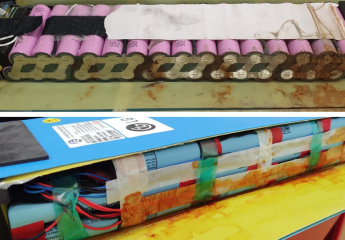

Other electronic and mechanical components, such as the controller, display, motor, wheel axles, bearings etc. also suffer from effects of water. If you are not sure about your scooter’s condition, have it professionally checked at our service shop.
safe riding
Conclusion
I keep supplementing and improving this text in order not to neglect any safety aspect of using electric scooters. My goal is to describe the problems realistically but without unnecessary scaring or simplification. I am sorry if I discouraged anybody from buying an electric scooter. I do think it is an amazing mode of transport that can be very safe and fun at the same time. However, if, after reading this text you feel that the electric scooter is not for you, then you better not buy any.
I will be pleased to hear any ideas for improving this “brief” safety guide, which I believe will help not just beginner riders. If I happened to neglect anything, forget, or fail to describe it correctly, or if you wish to commend me for this text, I will be happy to hear from you via this contact form. A guide like this can help thousands of riders around the globe. Presently, Max Blinker is working on having it translated into English, Czech, Hungarian and Russian, so that this guide reaches as many riders as possible.
- Did you find any error in the text? We would appreciate if you let us know. Report an error
- We will be pleased to hear a few kind words from you. Contact us. Commend Max Blinker
- Help us improve – do you have any new suggestions? Submit improvement suggestion
jan urbancikIf I helped just one rider to make his riding safer, then the task has been accomplished and writing this text down was worth it!


